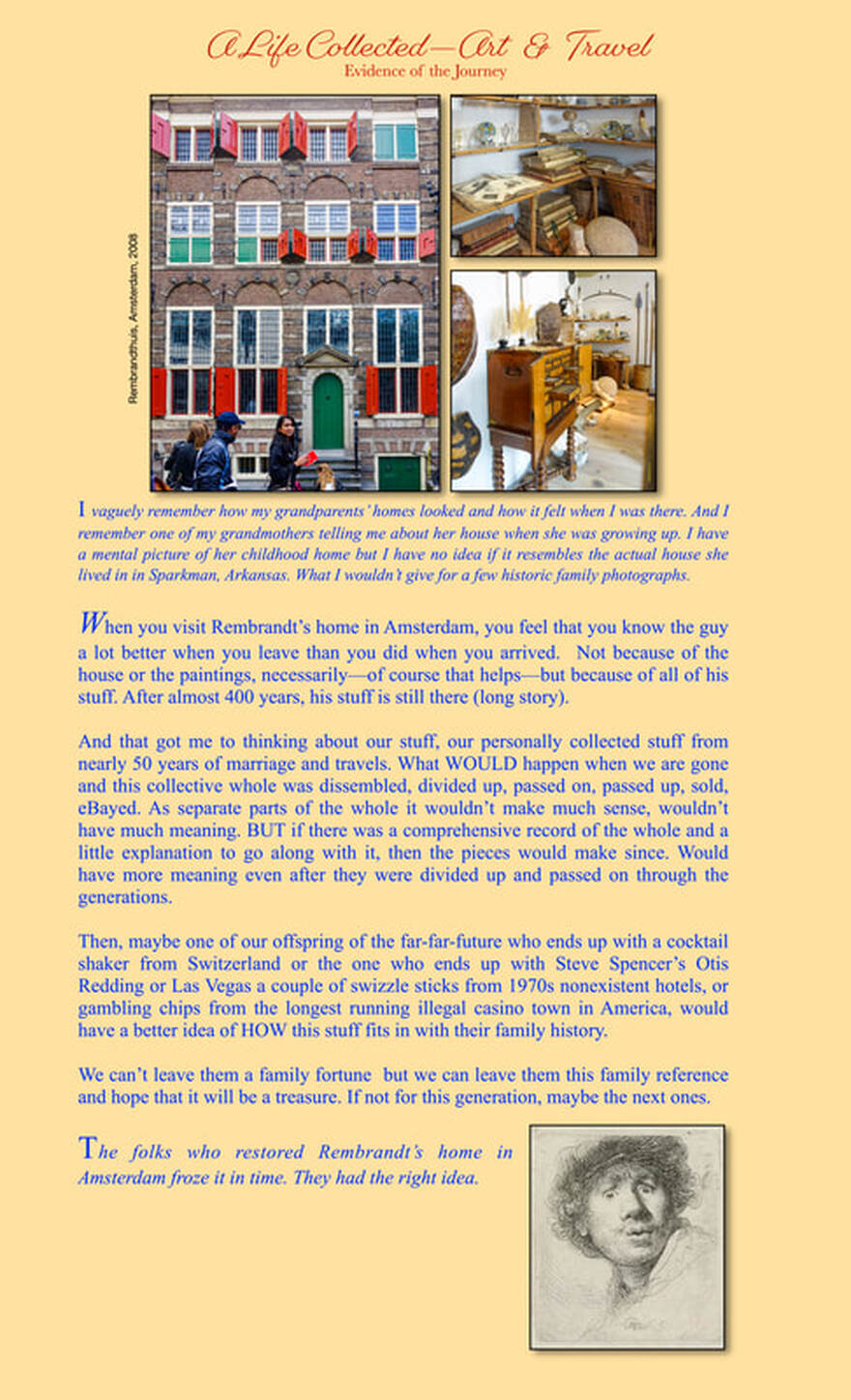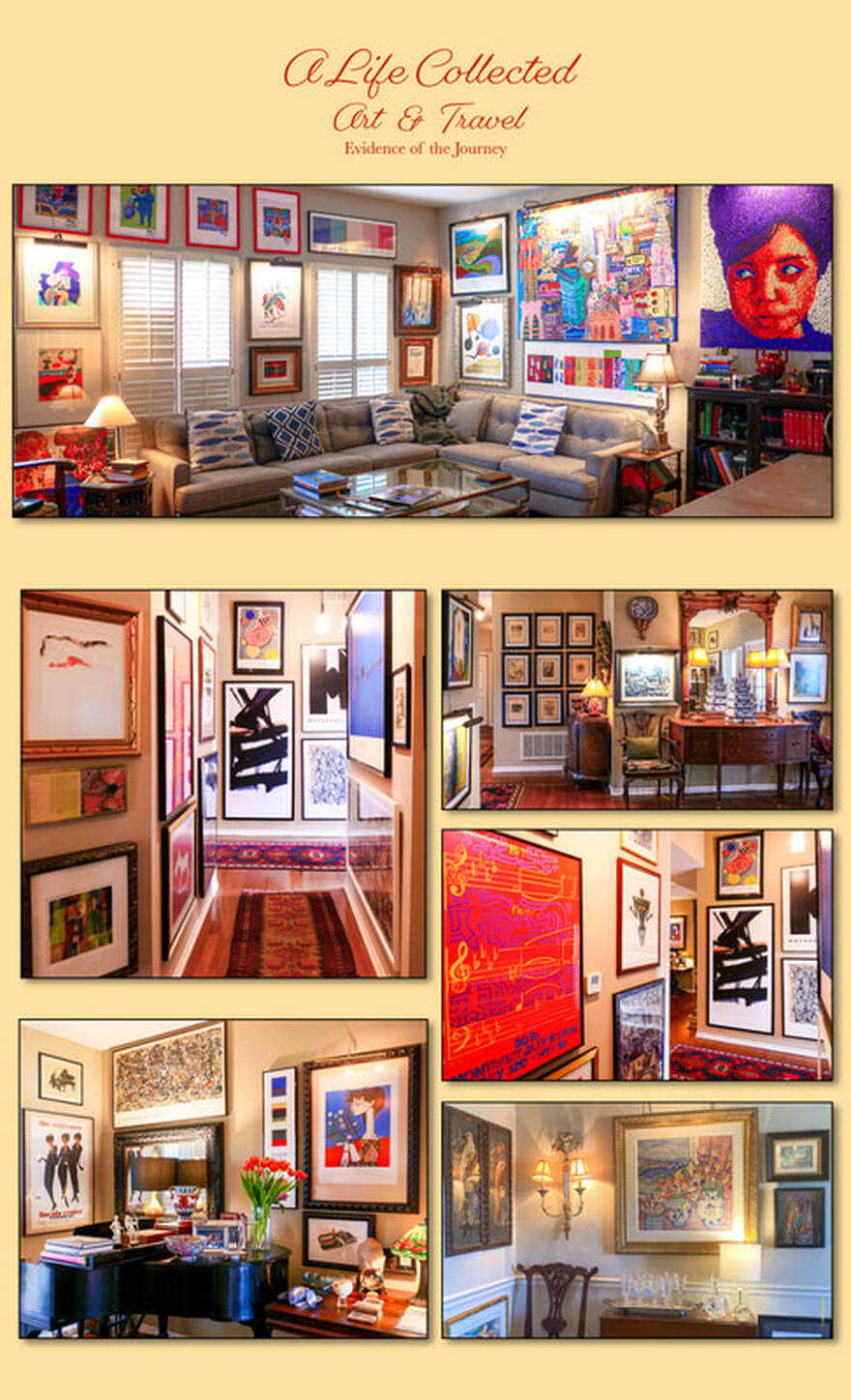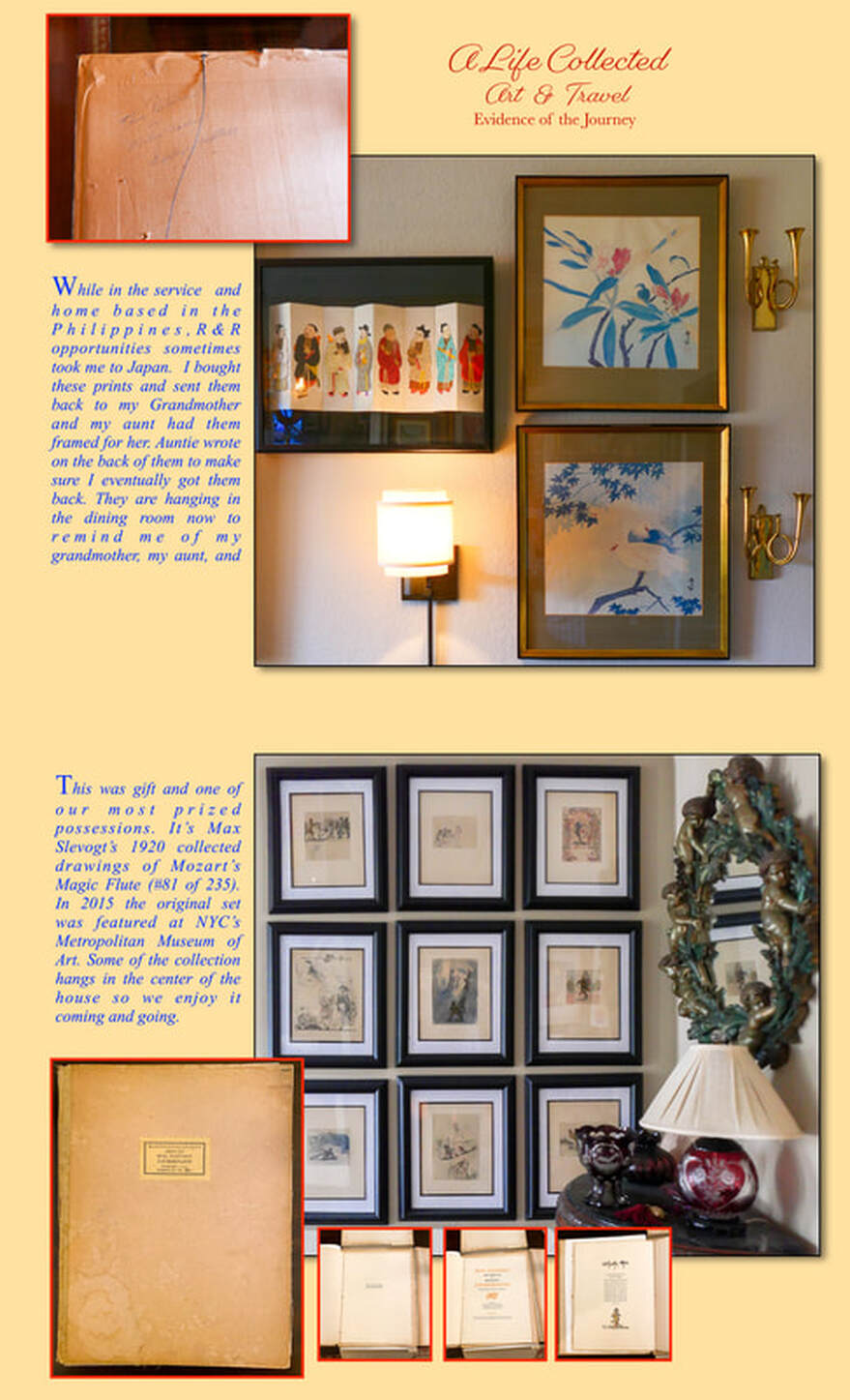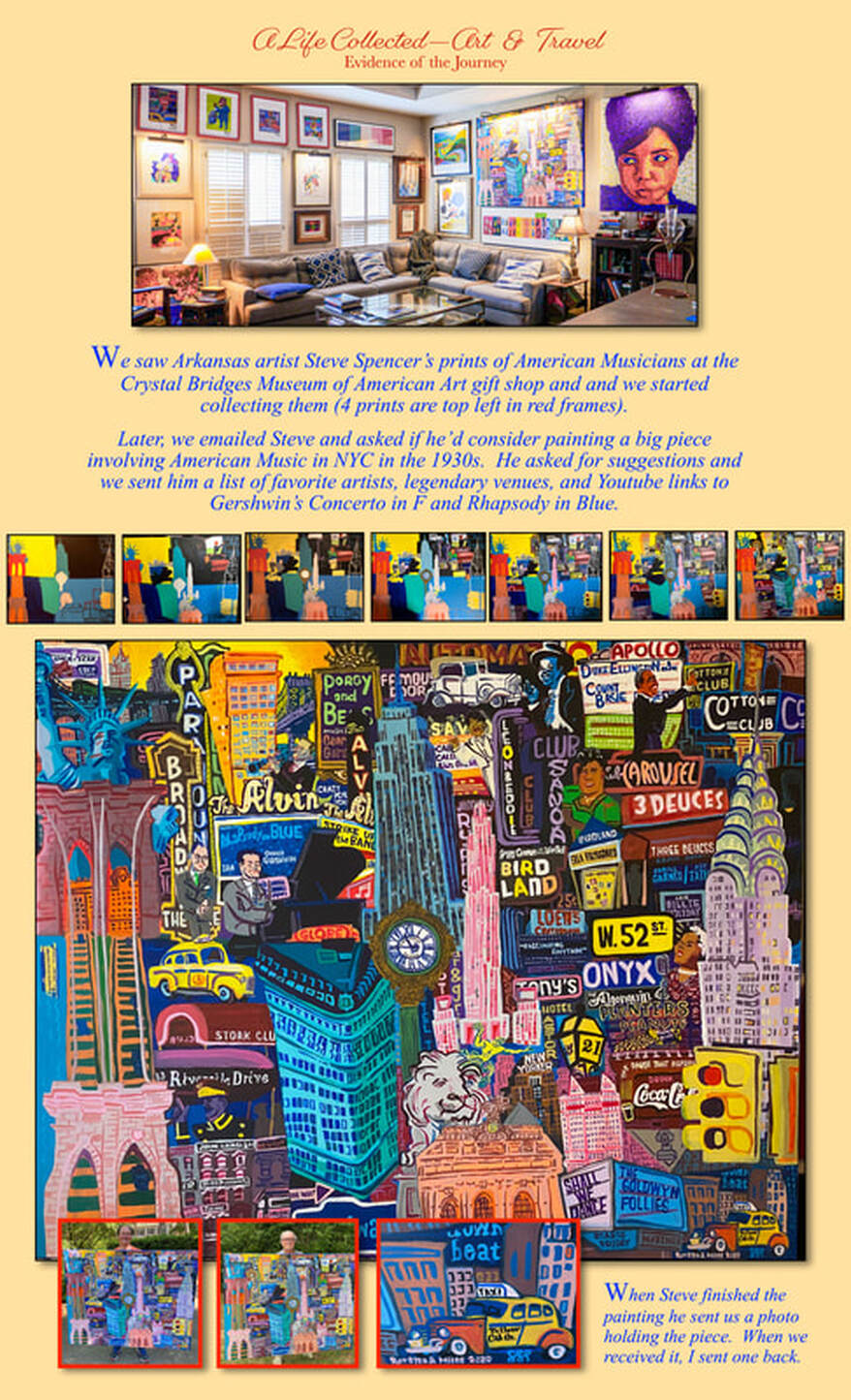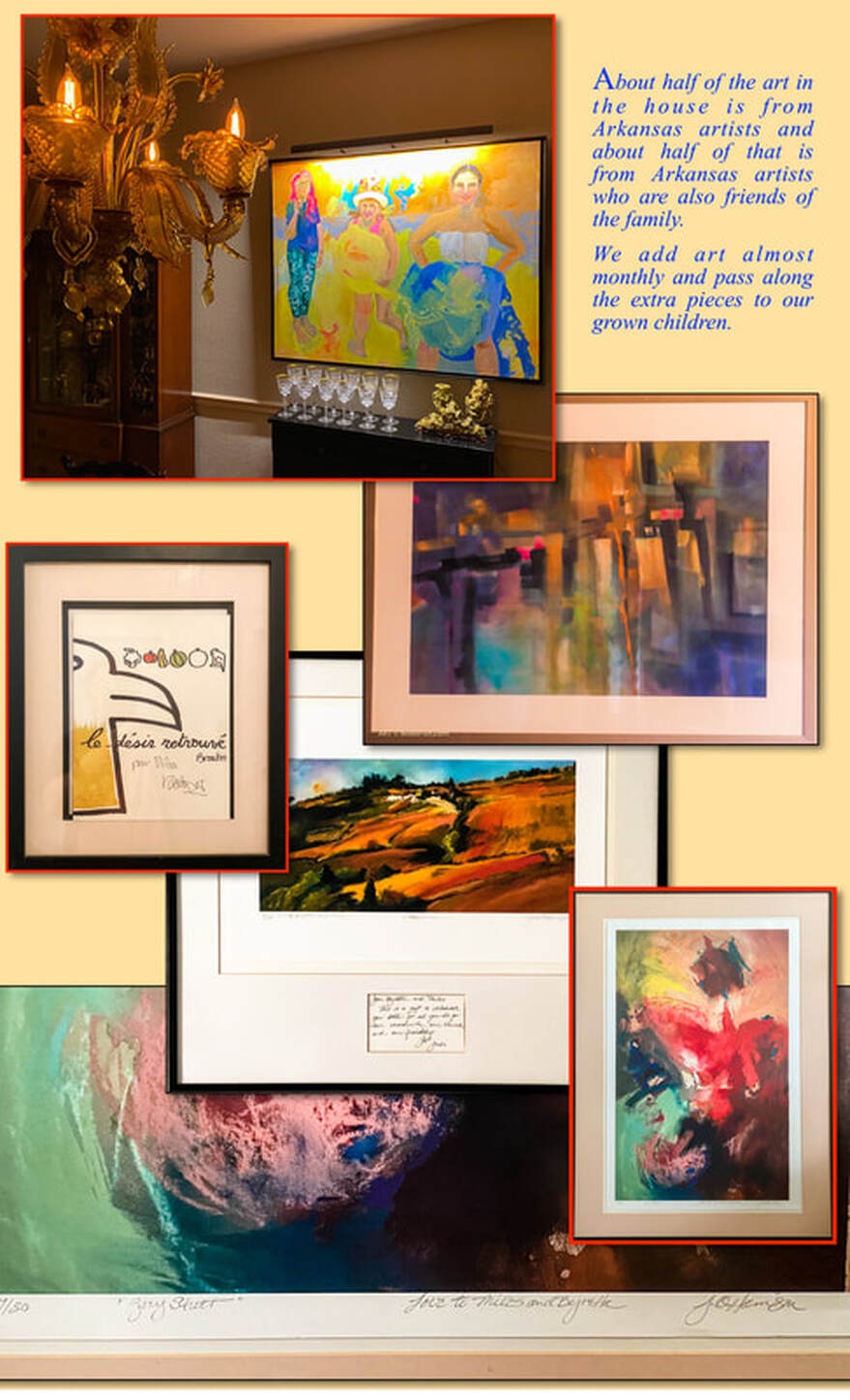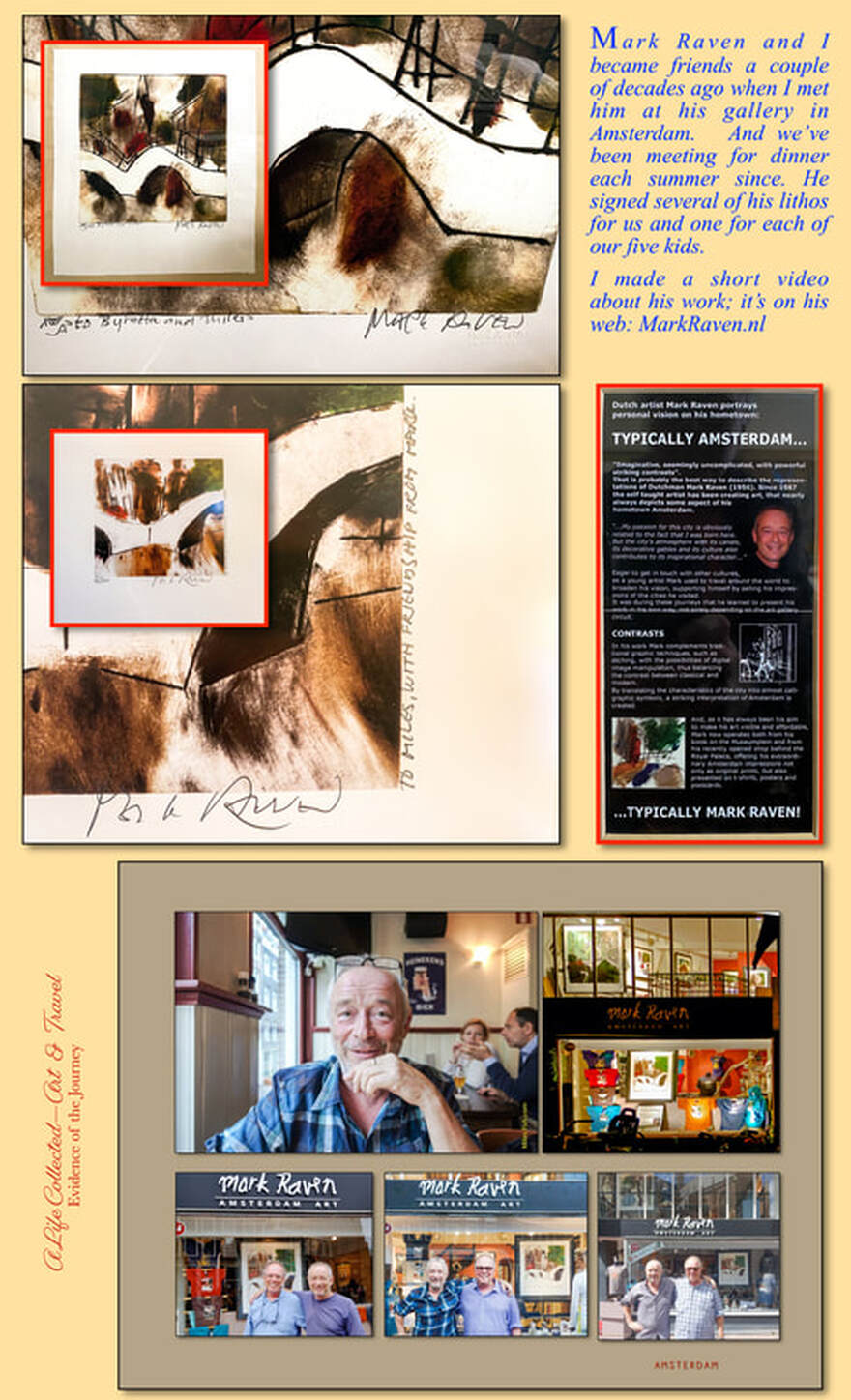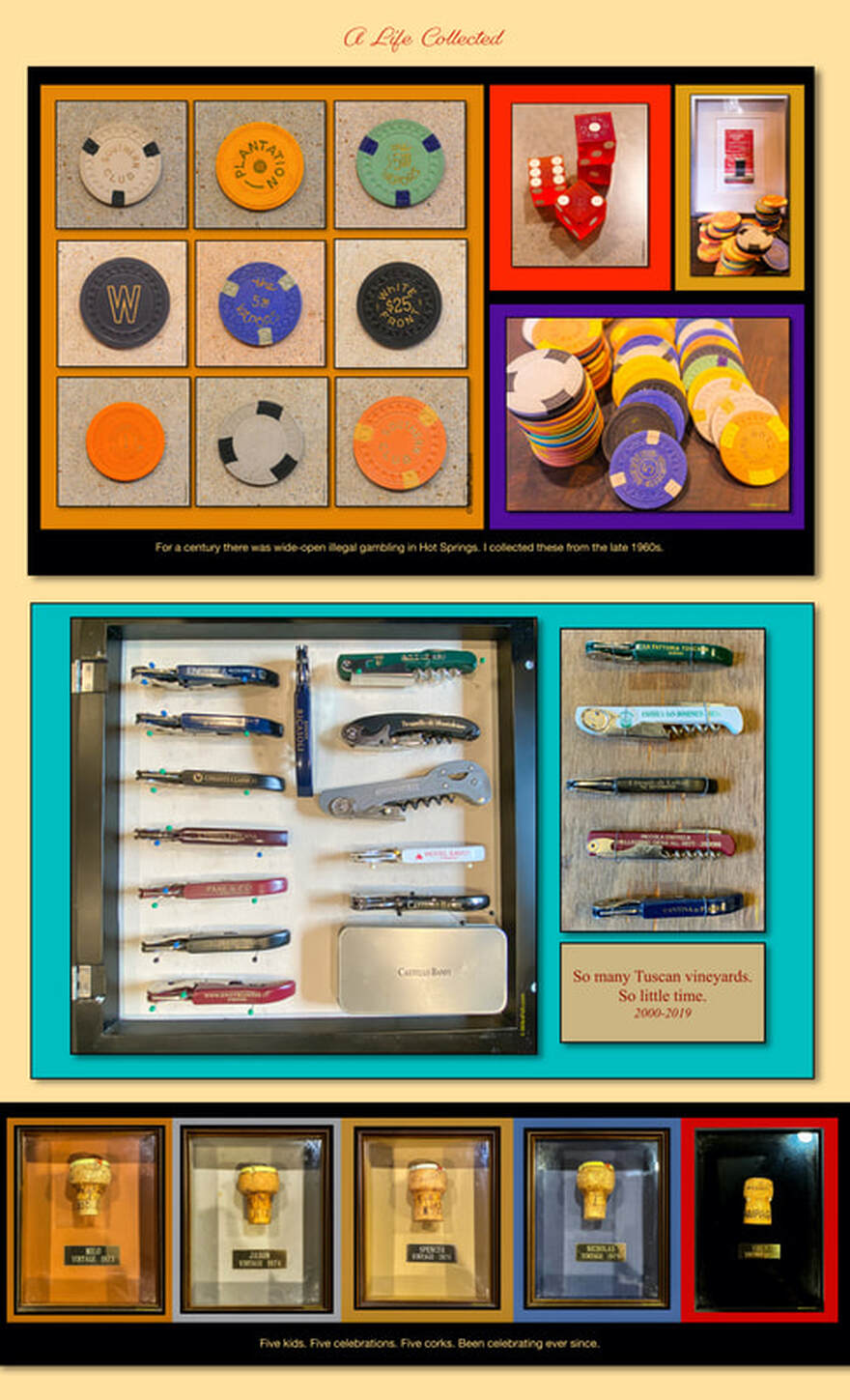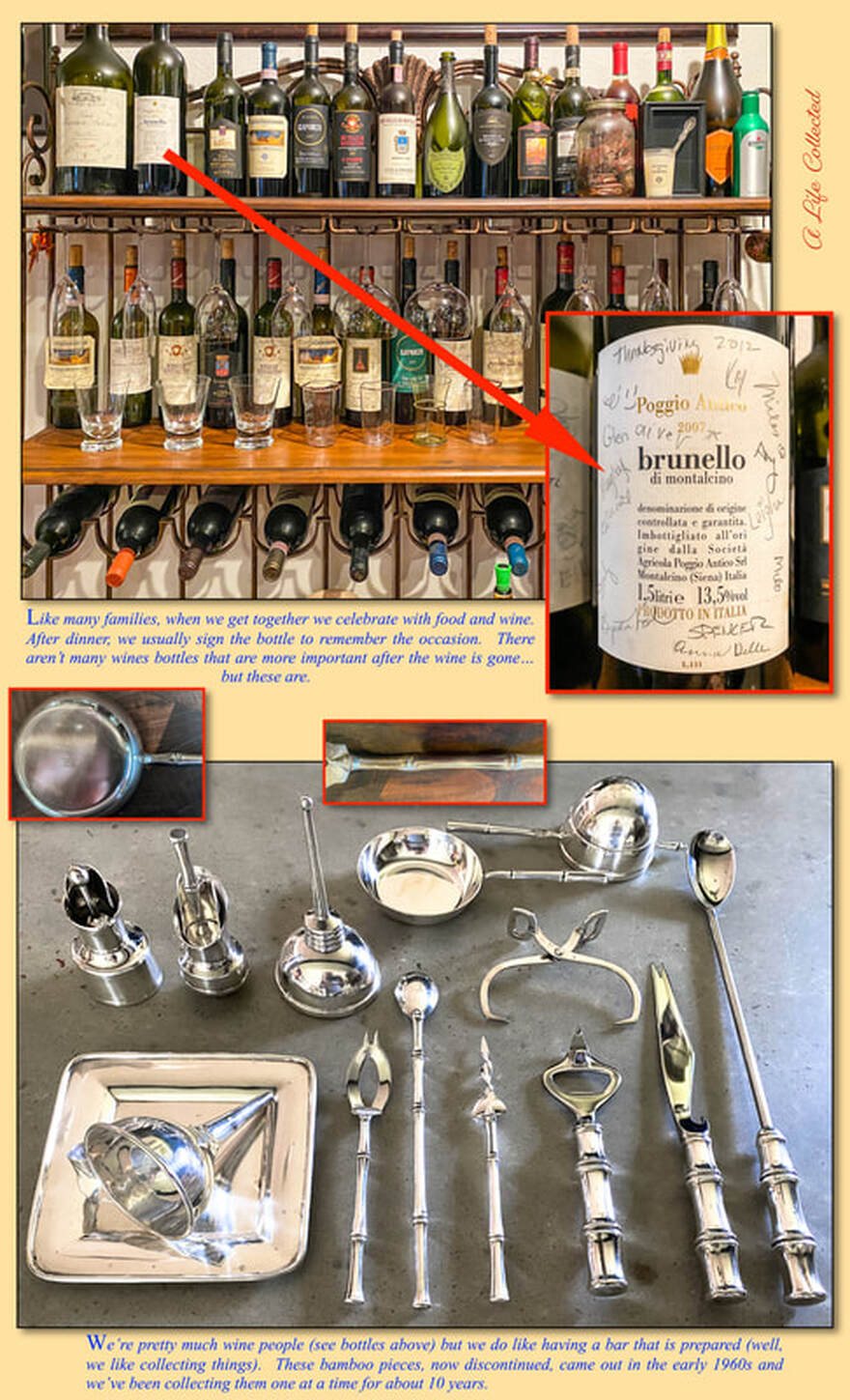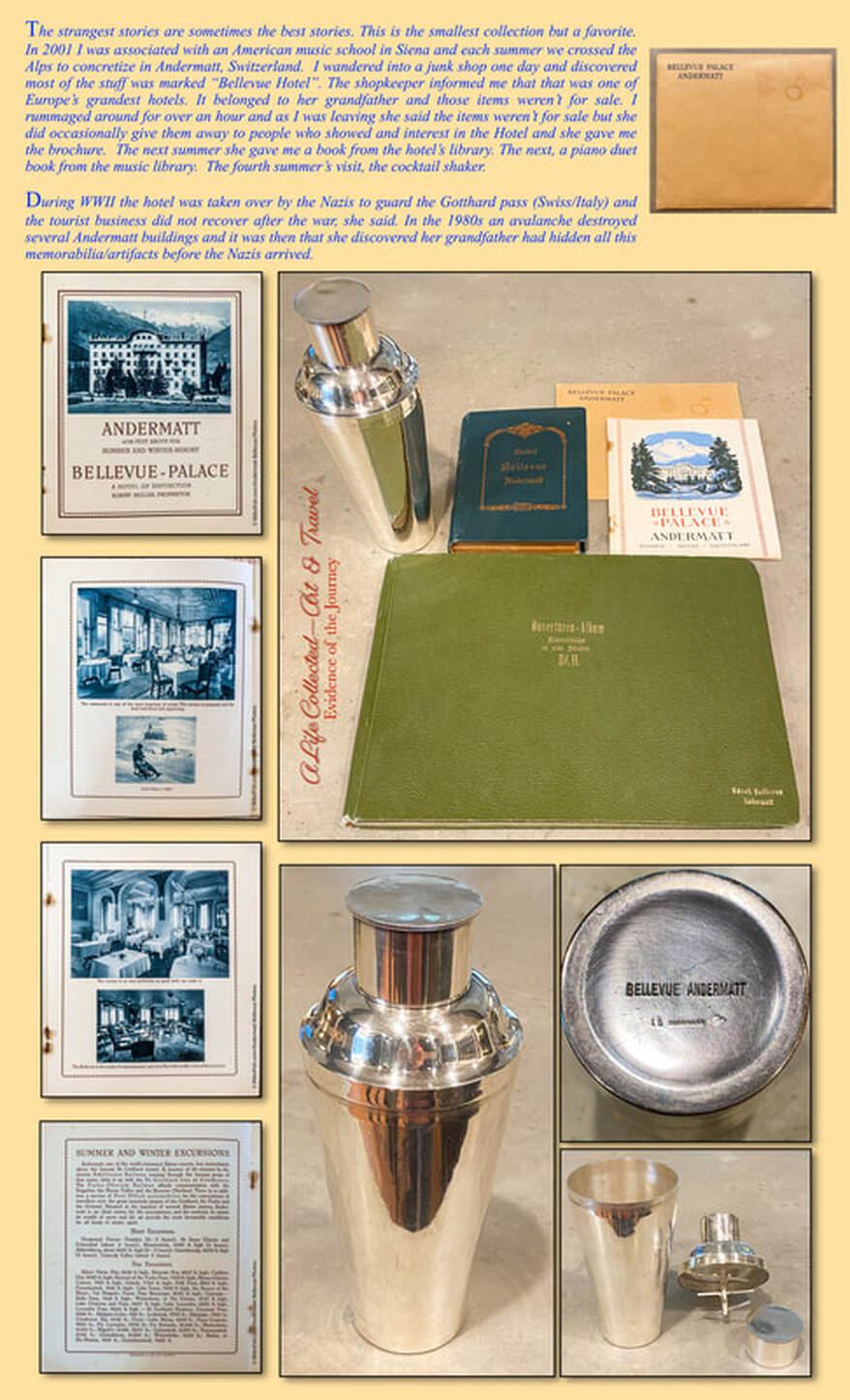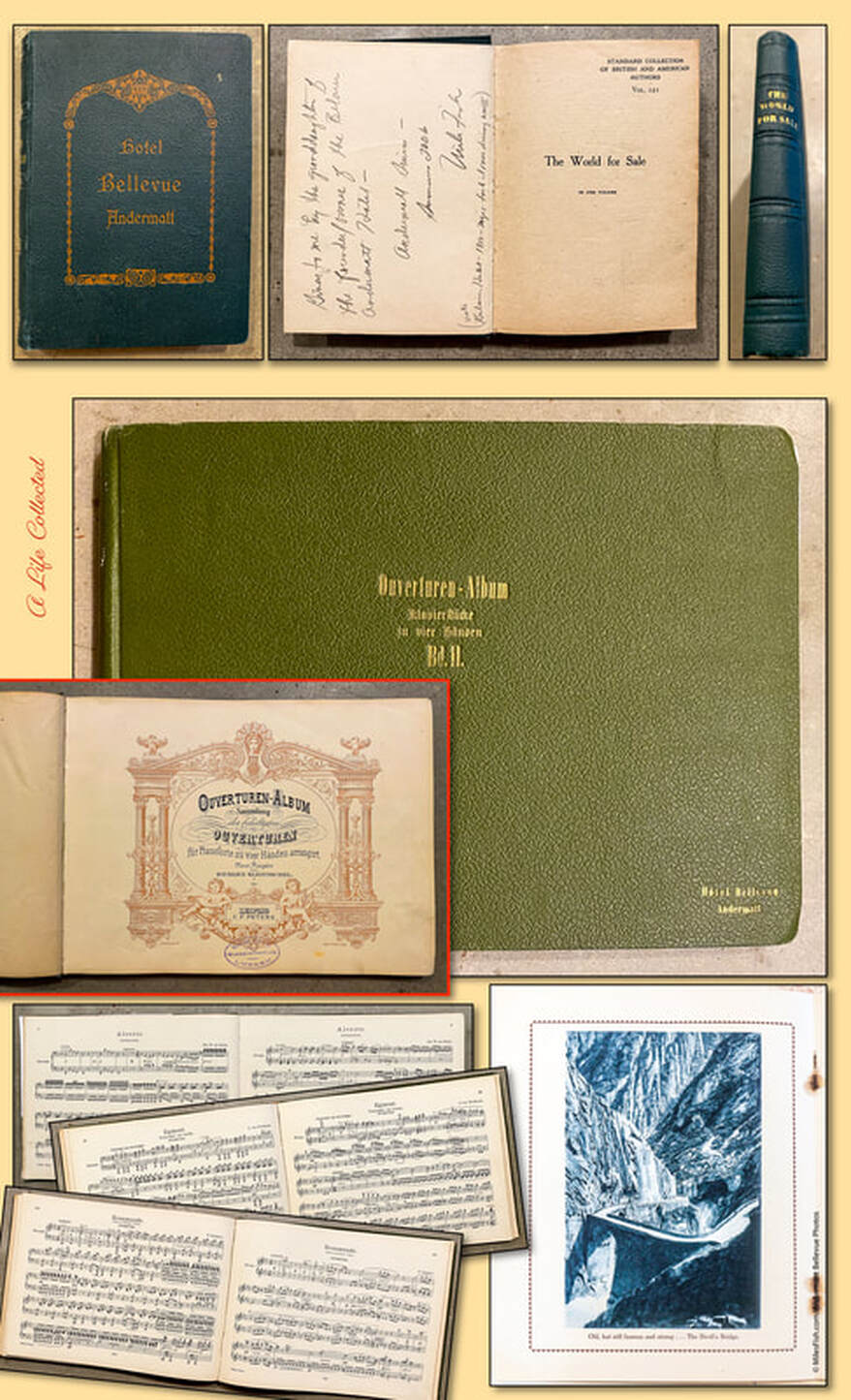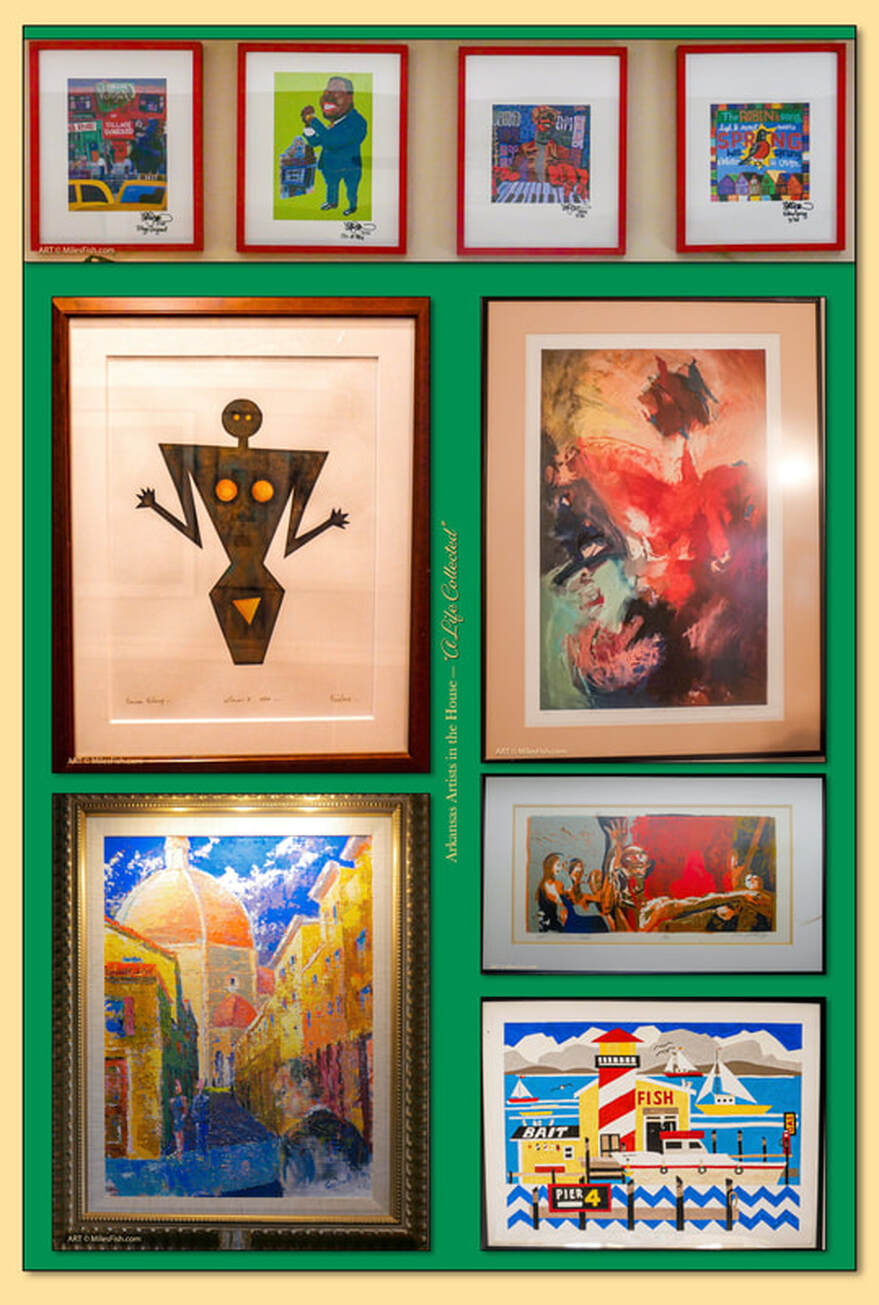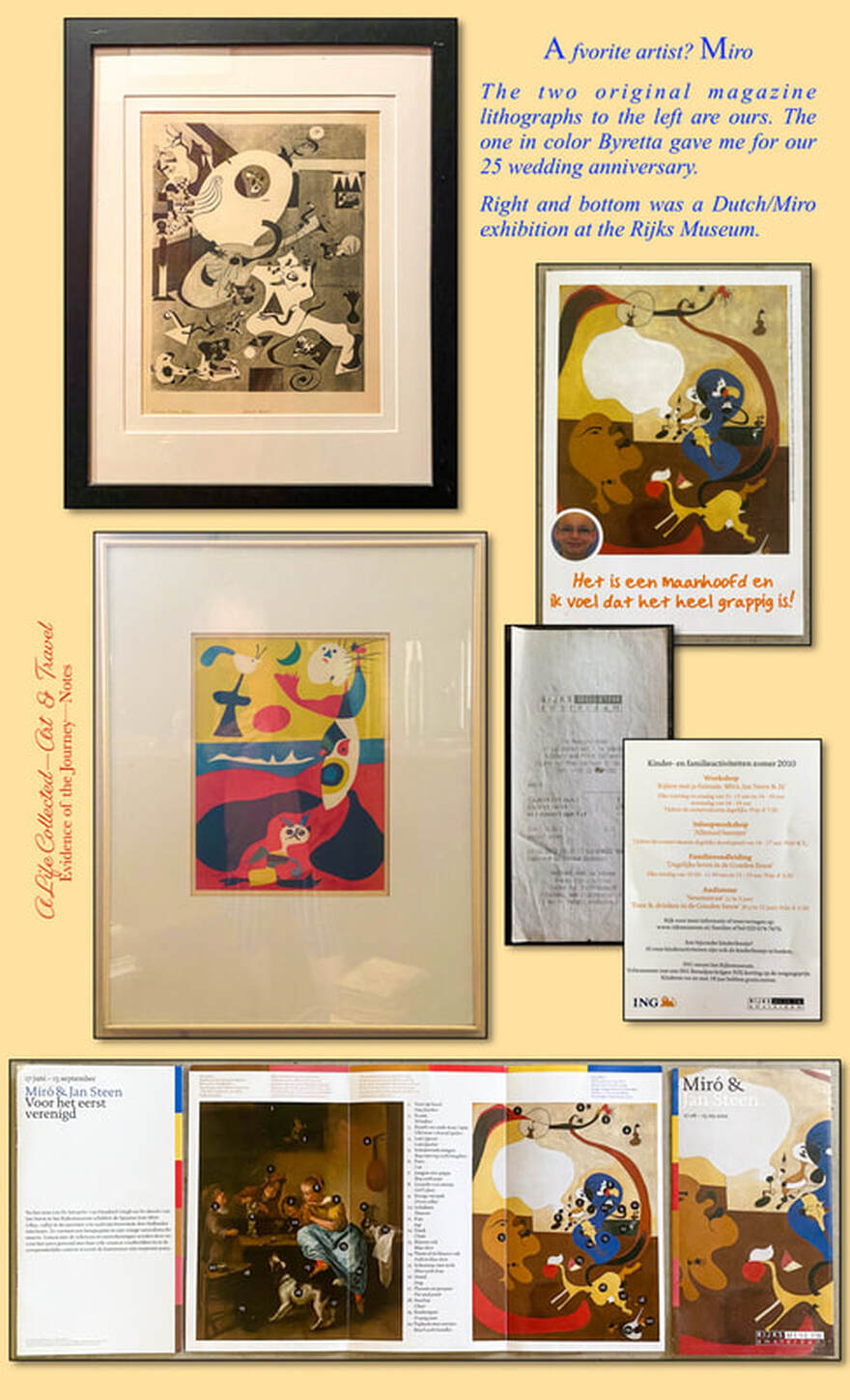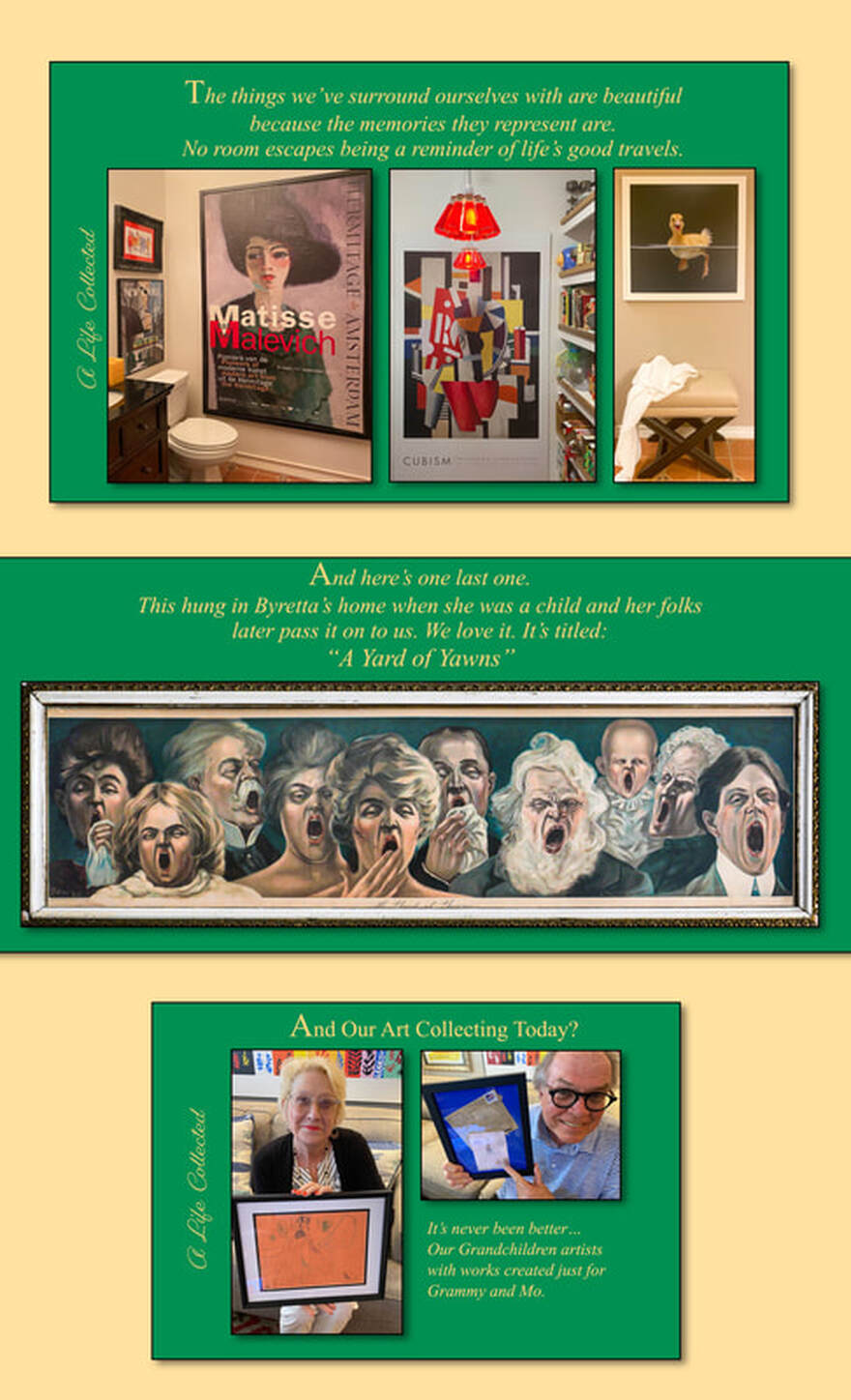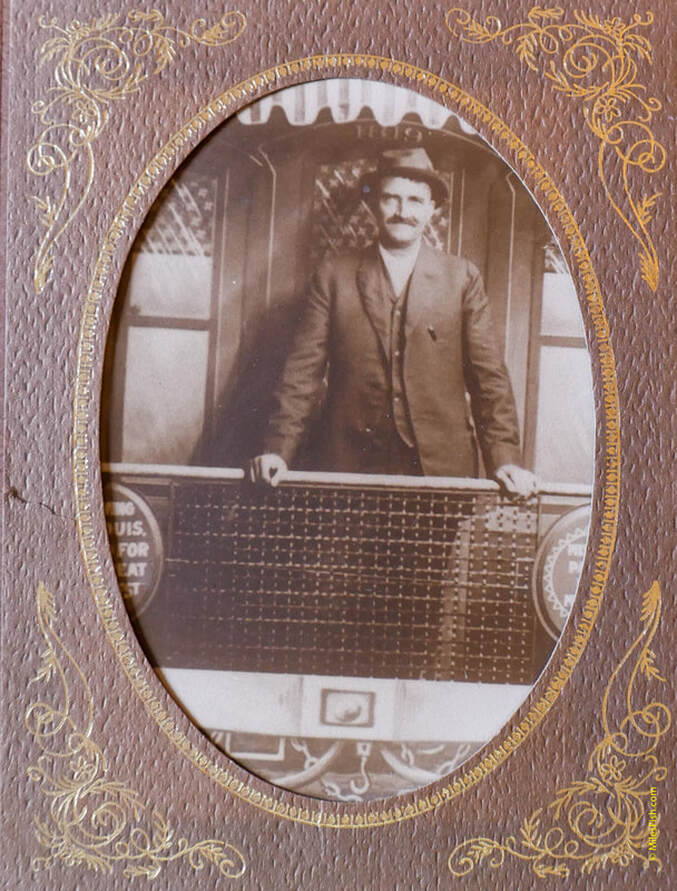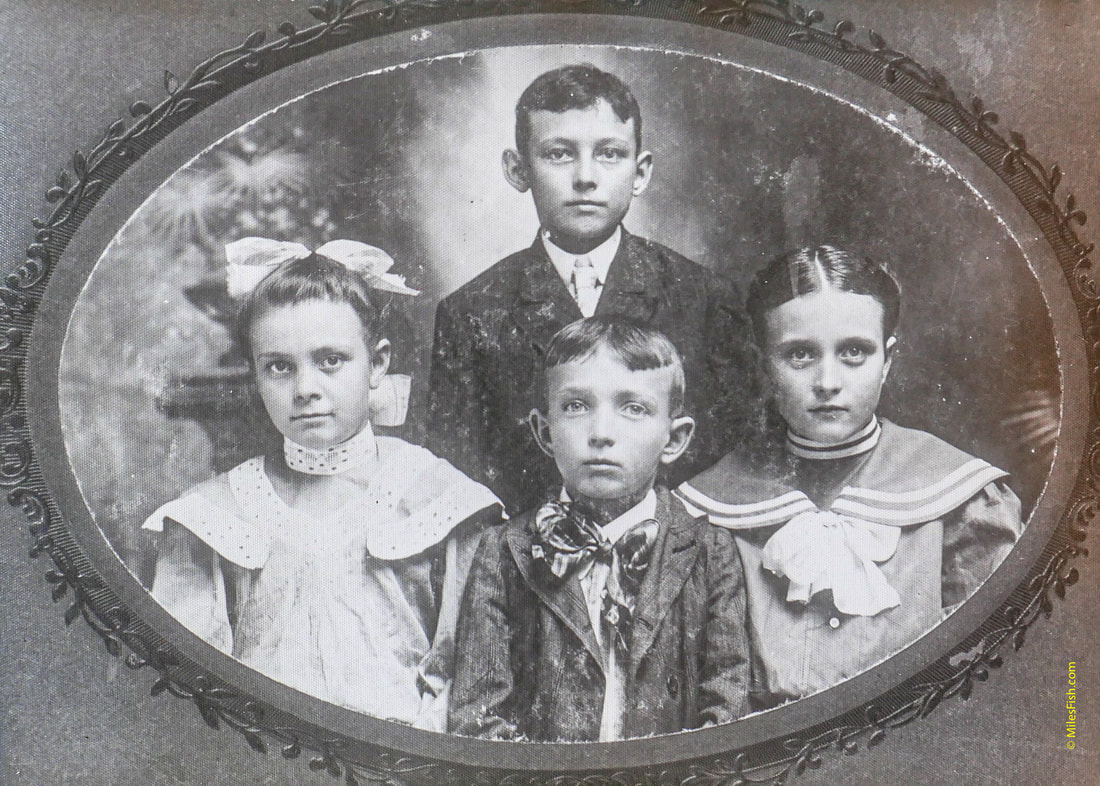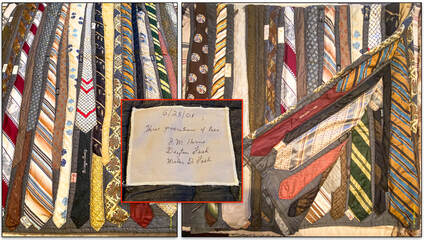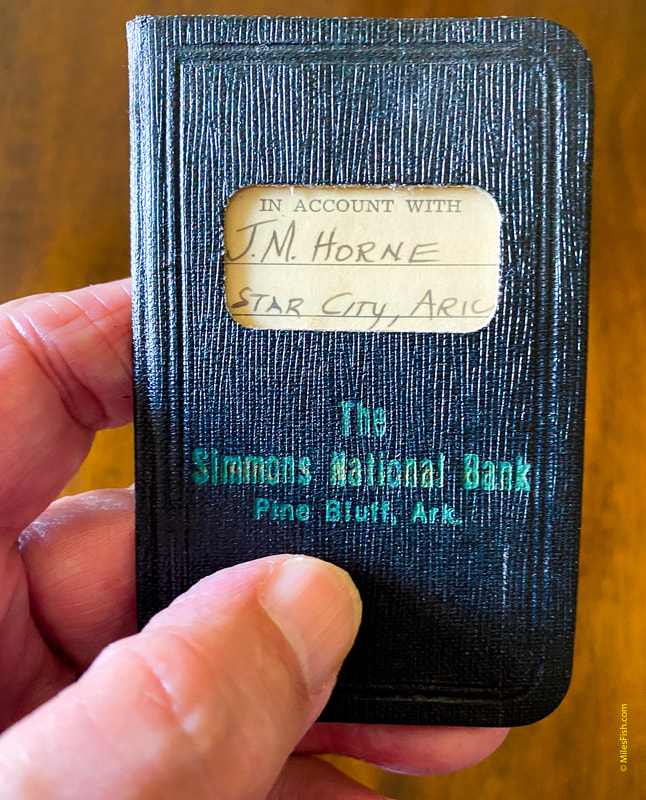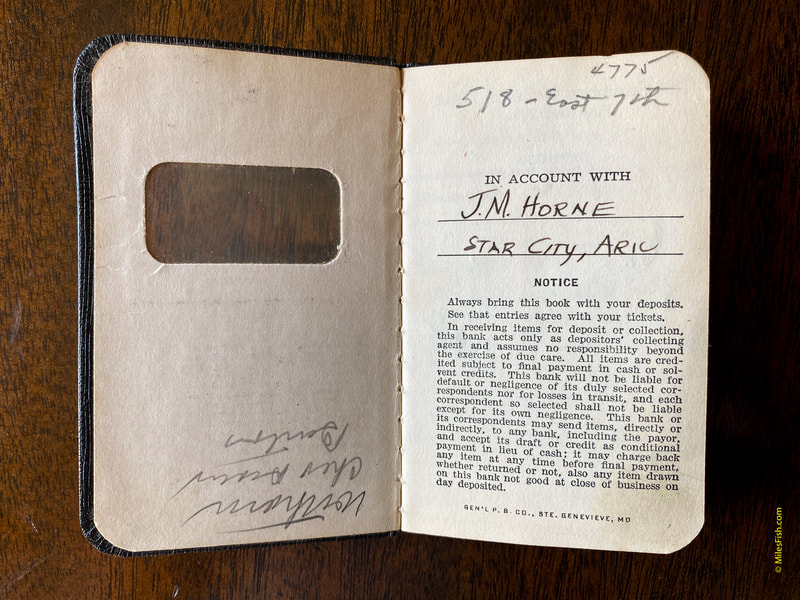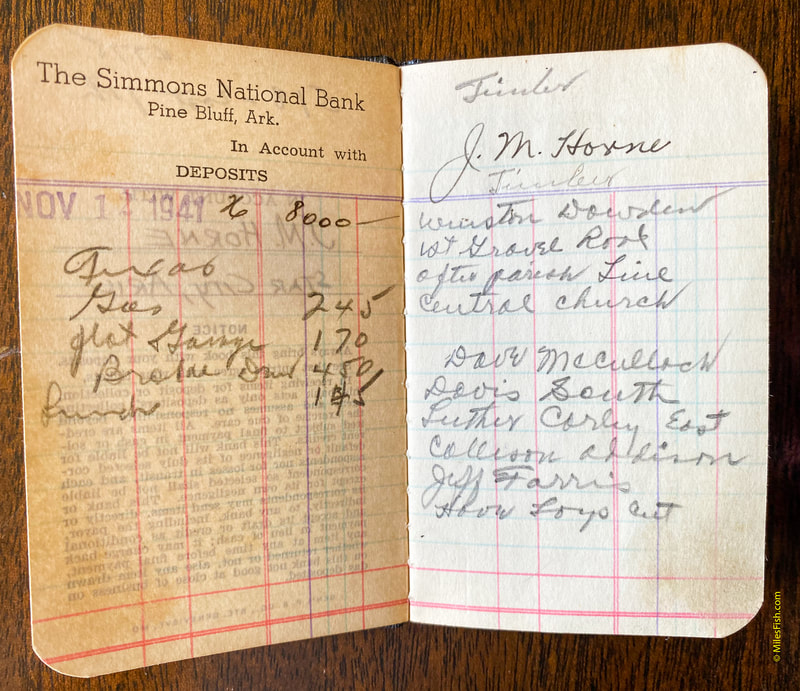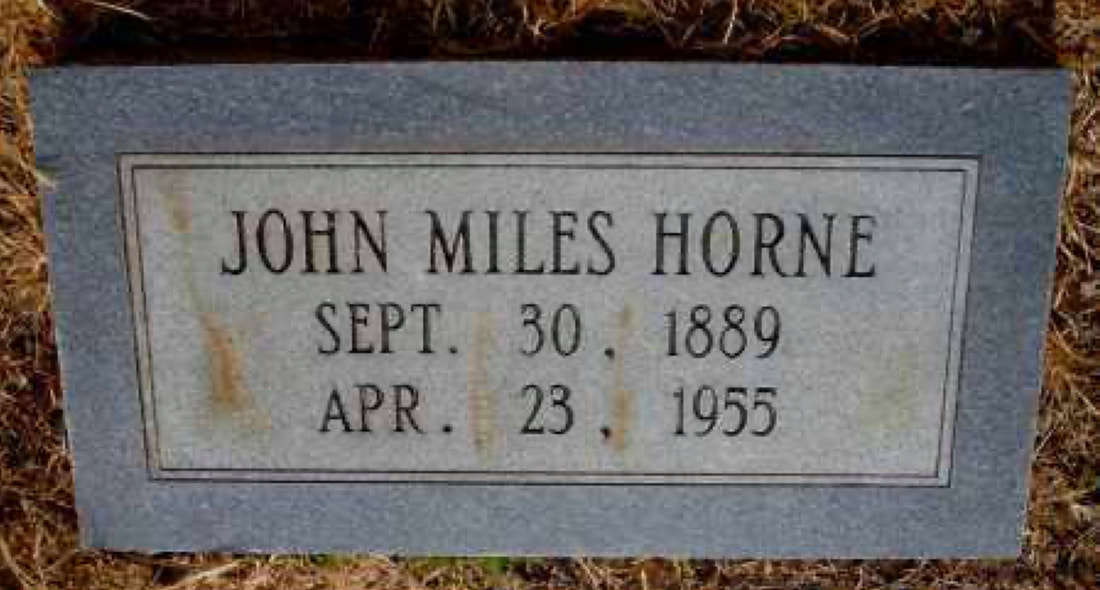FISH Pages
Collections (22pages)
Then a little History
_________________________________
Fish Ancestry
according to my 70 year old memories based on objects recently found in the garage
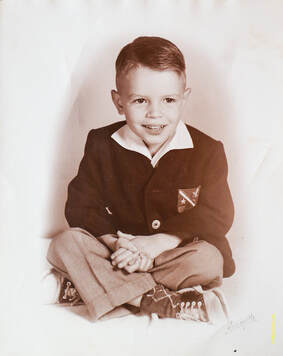
I found most of this small stash of photos featured below while cleaning out the garage. They were boxed up after Mother and Daddy's Bentonville house was sold. Some photos I remember seeing and some I do not remember at all. I thought I’d write down some of the things that came to my mind when I saw them and, more importantly, the names of your ancestors in the photos.
I’m pretty sure the names I've listed are correct. Also, I think the events I mentioned are accurate (but I confess that the older an event, the less sure I am of the authenticity of it so I Googled the family back in the 1800s early 1900s and when possible, backed up the "historic" stories I remember hearing with a little on-the-surface research).
Some of the events I associate with these photos are personal memories and some are memories of the stories I had heard. Actually, some of the memories I wrote about I didn’t KNOW I still had until I started typing and they just came flooding back in fractured random pieces. BigMamma’s chicken house when I was a young boy and BigDaddy’s garden and Granddaddy store in Gould and Grandmother’s sewing machine…my God, how long have those memories been inside my head un-visited?
Anyway, your ancestors' historical info is to my knowledge correct but the 70 year old memories may have taken on the likeness of an impressionistic painting. Our family, like families everywhere, is a history of so many stories and I'm sure everyone in my family has or had their own impressionistic version of our family history. Most of these stories, and places, and events, the family has talked about since I was born so there was no reason to write them down.
But now I look around and see that I'm one of the few persons left who has this family information and I realize that most of my children and grandchildren know little or none of it.
In the late 1800s a tremendous number of black musicians wrote and performed Rag-Time music; music that forever changed American music. Probably the only piano Rag Time we know today was by Scott Joplin (the Entertainer). He was one of the few composers of his day who was literate and wrote it down. As time passed so much great Rag Time music was lost because so many great composers left this world without having written it down. I didn't want that to happen to the few family stories I remember.
So, this is for you Fish Kids and all the Fish Kids that follow you and are becoming a part of this story. These old photos inspired me to write this for you and yours. (I'm kinda the Scott Joplin of Fish stories.)
I decided to put it online so I could occasionally add to it or, as I check into the history more, make corrections if necessary. Also, I put it online so you could view it in small doses if you liked. (after a while, I'll have a little "Staples" print edition made for you all just in case the website is lost.)
Your mother and I have in our possession all of the things pictured here.
I’m pretty sure the names I've listed are correct. Also, I think the events I mentioned are accurate (but I confess that the older an event, the less sure I am of the authenticity of it so I Googled the family back in the 1800s early 1900s and when possible, backed up the "historic" stories I remember hearing with a little on-the-surface research).
Some of the events I associate with these photos are personal memories and some are memories of the stories I had heard. Actually, some of the memories I wrote about I didn’t KNOW I still had until I started typing and they just came flooding back in fractured random pieces. BigMamma’s chicken house when I was a young boy and BigDaddy’s garden and Granddaddy store in Gould and Grandmother’s sewing machine…my God, how long have those memories been inside my head un-visited?
Anyway, your ancestors' historical info is to my knowledge correct but the 70 year old memories may have taken on the likeness of an impressionistic painting. Our family, like families everywhere, is a history of so many stories and I'm sure everyone in my family has or had their own impressionistic version of our family history. Most of these stories, and places, and events, the family has talked about since I was born so there was no reason to write them down.
But now I look around and see that I'm one of the few persons left who has this family information and I realize that most of my children and grandchildren know little or none of it.
In the late 1800s a tremendous number of black musicians wrote and performed Rag-Time music; music that forever changed American music. Probably the only piano Rag Time we know today was by Scott Joplin (the Entertainer). He was one of the few composers of his day who was literate and wrote it down. As time passed so much great Rag Time music was lost because so many great composers left this world without having written it down. I didn't want that to happen to the few family stories I remember.
So, this is for you Fish Kids and all the Fish Kids that follow you and are becoming a part of this story. These old photos inspired me to write this for you and yours. (I'm kinda the Scott Joplin of Fish stories.)
I decided to put it online so I could occasionally add to it or, as I check into the history more, make corrections if necessary. Also, I put it online so you could view it in small doses if you liked. (after a while, I'll have a little "Staples" print edition made for you all just in case the website is lost.)
Your mother and I have in our possession all of the things pictured here.
This is Zachary Decatur Sparkman (photo above). He was my great-grandfather, makes him Milo/Jason/Spencer/Nicholas/Emily’s great-great-grandfather and yall's kids' great-great-great-grandfather. He and his older brother Pete established a sawmill in Arkansas’ Dallas county and in 1892 Pete founded the settlement and gave it the family’s name and the new municipality became Sparkman, Arkansas. When the Rail Road came through that part of Arkansas, it miss the town by about a mile …so…Pete moved the town. When BigMamma was growing up they referred to the two nearby locations as Old Sparkman and New Sparkman.
Pete was also the town’s first Post Master (when you can name the town then move the town I guess you get to be whatever you want to be.) BigMamma told me that the family had their own rail road car (however, this photos is not on that car). Two stories I remember her telling me about living in Sparkman: 1) When Halley’s comet appeared (in 1910) she said people had been warned that it would signify the end of the world was arriving with that comet, citizens of Sparkman gathered at the churches to pray and when the comet finally passed over and they were all still alive and well, she said people were in the streets on their knees giving thanks that Sparkman been spared. 2) She remember fondly the day their first car arrived as being a joyous occasion for the family and for the town. It arrived by flatbed train car. (I don’t know if it was the first car in town or just THEIR first.)
Pete was also the town’s first Post Master (when you can name the town then move the town I guess you get to be whatever you want to be.) BigMamma told me that the family had their own rail road car (however, this photos is not on that car). Two stories I remember her telling me about living in Sparkman: 1) When Halley’s comet appeared (in 1910) she said people had been warned that it would signify the end of the world was arriving with that comet, citizens of Sparkman gathered at the churches to pray and when the comet finally passed over and they were all still alive and well, she said people were in the streets on their knees giving thanks that Sparkman been spared. 2) She remember fondly the day their first car arrived as being a joyous occasion for the family and for the town. It arrived by flatbed train car. (I don’t know if it was the first car in town or just THEIR first.)
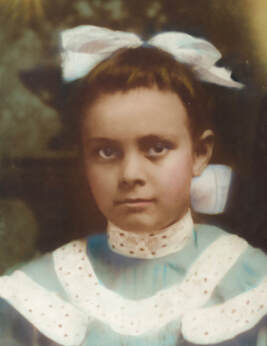 Evie Lena Sparkman
Evie Lena Sparkman
Evie Lena Sparkman (left, and below left with her siblings). The boys were my great Uncle Dallas and great Uncle Demps, Her sister died young I think (and I can’t recall her name). Not too long after the group picture was taken, their mother died. Zach remarried and BigMamma said that “new-mother” did not especially like children so all of them were sent away to boarding schools. She was sent to Galloway, a year-round School for Girls in Searcy and one of the oldest Methodist schools in Arkansas. Galloway later merged with several other Methodists schools to become what is now Hendrix College in Conway—and one of the reasons why Mother attended Hendrix as a legacy.
One of BigMamma's brothers in the photo survived and like she, lived to a relatively old age and his wife, my great Aunt Gladys who I dearly loved and who came from Texas every year to stay with us for several weeks liver longer. She and BigMamma were sisters-n-law but as close as any sisters you could ever know and I never saw BigMamma so happy as the times when Aunt Gladys was with us. I knew their descendants Jimmy Sparkman and Sybil (and their children Sparky and Skipper) Because they would come to Star City to visit in the summers and on at least one occasion my family went to Galveston Tx to visit them.
When your mother and I lived in Hawaii Sybil and Jimmy came to Oahu and we met them there, when Byretta and I were stationed in California we met Sparky (career Navy) and his wife for dinner one night at their house.
One of BigMamma's brothers in the photo survived and like she, lived to a relatively old age and his wife, my great Aunt Gladys who I dearly loved and who came from Texas every year to stay with us for several weeks liver longer. She and BigMamma were sisters-n-law but as close as any sisters you could ever know and I never saw BigMamma so happy as the times when Aunt Gladys was with us. I knew their descendants Jimmy Sparkman and Sybil (and their children Sparky and Skipper) Because they would come to Star City to visit in the summers and on at least one occasion my family went to Galveston Tx to visit them.
When your mother and I lived in Hawaii Sybil and Jimmy came to Oahu and we met them there, when Byretta and I were stationed in California we met Sparky (career Navy) and his wife for dinner one night at their house.
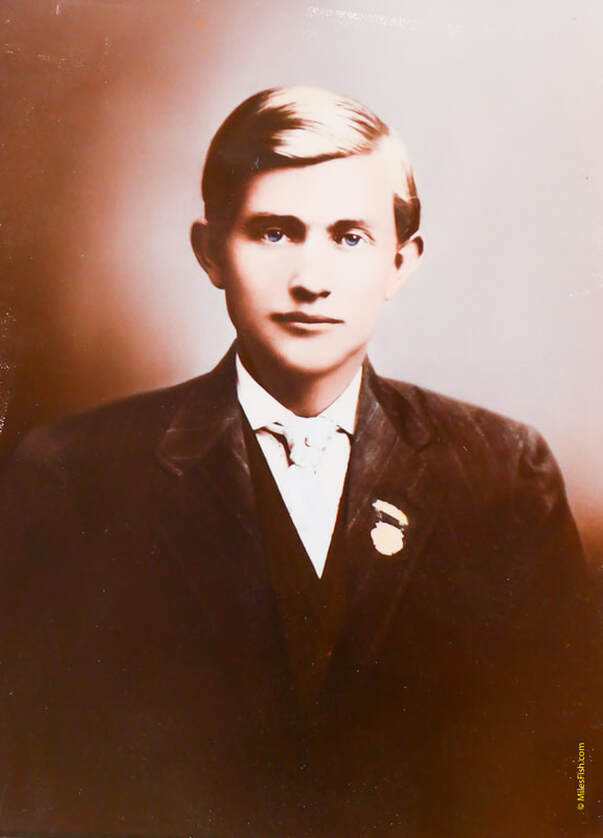 John Miles Horne
John Miles Horne
This is John Miles Horne (photo below), mother’s dad, my grandfather and namesake, and the guy that bought me my first pair of cowboy boots (boots that were a little too large so they rubbed blisters on my heels but I refused to stop wearing them so they stuffed the boots with with Kleenex until my feet grew a bit...so the story goes).
His family was originally from the Gurdon, Arkansas area and part of a sawmill family there. As I understand the family history and the online records, in 1913 the Horne family established another sawmill, along with a ginning company, in Sparkman and then later the Horne family established the town's first electrical company.(There is still a Horne Street in Sparkman, AR.)
John Miles Horne married Evie Lena Sparkman in Sparkman and then they moved to Star City and established yet another family sawmill and he also began investing in forest and forest management.
For at least two decades, J.M. Horne Timber and the Star City Horne Lumber Mill was the town’s main industry. Sounds very Tennessee-Williams Faulknerisque, we called him BigDaddy and everyone else—white, black, man, woman—called him Cap’n Miles.
I remember, as a young boy, being in Grady Haygood's barbershop one day (Grady was Glenda Fish's dad) and a bunch of old-timers were talking about the “sawmill days” and they commented that back then you could go, as the crow flies, from Star City to Hope, Arkansas without ever leaving J.M. Horne Timber land. They didn’t know I was his grandson until Grady Haygood, told them after their conversation and they all shook my hand (although, as I look back, this seems like a kind of Hallmark(ish) moment it has stayed with me to this day). When I got home I asked mother if what they said was true and she said it might be a stretch but close to the truth, that he had systemically amassed large areas of Arkansas forest land during and after the great depression. BigDaddy also had forest land for exotic woods and a mill in Honduras (Lynda Horne Vick spent several of her growing-up years at the properties in Central America when her dad, Leon Horne(Uncle Brother, Mother's brother)—later of Leon’s Catfish in PB—was there as manager).
BigDaddy’s portrait here is from High School, the medal he is wearing (and I understand was proud of until the day he died) is the Elocution Medal he was awarded for being the outstanding public speaker in his high school. Apparently he was a smooth talker all his life. From what I remember hearing and what family members have told me, I believe he was truly beloved in Lincoln County. Apparently he had a reputation of being fair, honest, and generous to a fault...would give you the shirt off his back and all that...I heard that often enough growing up to believe it was true. And he was civic minded…President of the School Board and those sorts of things (as a matter of fact, my dad was appointed to the S.C. School Board to fill the position when BigDaddy died).
BigDaddy's stuff: The ties, the Simmons Bank book, and his travel clock are the only object I know of that still exist that were his. Somethings he touched, that he used, that was part of his life.
About the Simmons Bank book. Nov 1, 1941 he made a deposit of $8,000. I Googled that amount for 1941 and equivalent amount today would be just over $142,000.00. That amount is impressive enough and even more interesting when you consider that he did most of his banking at the Bank of Star City. Isaac Chambers, bank president, was one of his best friends. So it's possible this was an off-shore account. Who knows. Also notice the expenses the day he made the deposit: gas $2.45, flat fixed at the garage $1.70, Broken (something) $4.50, and lunch $1.45 (which Googles out to be $26.60 in 1941). The following page in his book contained notes about "J.M.Horne Timber".
About the Simmons Bank book. Nov 1, 1941 he made a deposit of $8,000. I Googled that amount for 1941 and equivalent amount today would be just over $142,000.00. That amount is impressive enough and even more interesting when you consider that he did most of his banking at the Bank of Star City. Isaac Chambers, bank president, was one of his best friends. So it's possible this was an off-shore account. Who knows. Also notice the expenses the day he made the deposit: gas $2.45, flat fixed at the garage $1.70, Broken (something) $4.50, and lunch $1.45 (which Googles out to be $26.60 in 1941). The following page in his book contained notes about "J.M.Horne Timber".
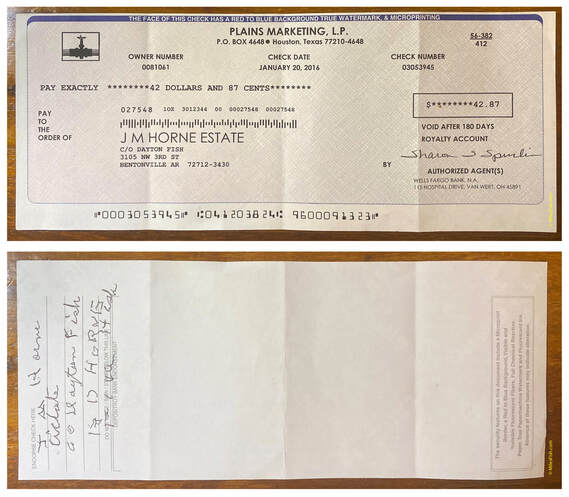
I once asked my dad, who loved sports of all kinds, why he stopped going to the races at Oakland Park in Hot Springs. He said that the day the Star City sawmill burned to the ground, they were all in Hot Springs at the races. He vowed then he would never go back. And even after he bought his own lake house in Hot Springs he never returned to the track. (He was a man of his word.)
After the war, my dad had set up a small retail lumber yard in Star City beside the J.M. Horne sawmill; he locally sold retail what the BigDaddy’s mill sold commercially nationally. The day of the fire, the entire mill complex—offices and all—burned to the ground but not my dad’s small retail yard (located where the Ford dealership was when yall were growing up there). What remained became Fish Builders’ Supply and Lincoln Construction Company. Fish Builders’ Supply moved to its permanent location between the town square and the highway. After the fire, the lumber mill was rebuilt but never approached its former prosperity days. There was very little commercial insurance back then so lots of liquidating and money-borrowing was involved, I understand, in the rebuild. BigDaddy was an alcoholic and his alcoholism hit a rapid downward spire about then, I understand he would start drinking and disappear for days at a time. (He went to two different out-of-state rehab clinics before celebrity rehabs were cool.) Then the mill burnt to the ground a second time and it was never rebuilt. Robbie Ray Atkinson and I used to play in the mill ruins when we were kids. What was known as The Mill-Quarters—clusters of small houses nearby for the mill workers—did not burn the second time and were still inhabited when I was in high school.
Before BigDaddy and BigMamma moved to Star City there were soil tests showing that there might be oil in the Sparkman area so he invested in several oil wells but none of them ever paid off. (However, for a long time we continued to get annual tiny check—photo enclosed—from the oil company but after Daddy died the bank would not let me deposit them…even with mother’s signature endorsement…the last check was in 2016)
I loved BigMamma and BigDaddy’s house in Star City. It was a single story clapboard painted white with big windows and tall ceilings and it sat on a couple of really shaded lots. It sat high up on a raised foundation with a tall crawl space between the ground and the floor. There was a two car detached garage to the right (as you faced the house) with a kitchen entrance and side house entrance. An additional full lot of shade trees and green grass in the summer and daffodils and red spider lilies in season to the left with a short white fence at the front of the side yard near the road and a tall solid white wood fence with a foot of lattice at the top of it at the back.
The back yard was big and shady also and there was a “sleep-in” screened back porch attached across the rear of the house. Outside the screened porch there were giant hydrangeas bushes from one end of the house to the other and they grew all the way to underneath the kitchen window. Still, to this day, when I seen hydrangeas I instantly think “oh, those are kitchen flowers” because that’s what I called them then and visions of that yard flashes back every time I see those flowers.
There was a small white clapboard additional house—like a freestanding apartment—to the rear of the back yard where Mary Ryles (who looked after the house and helped with the cooking) lived. After BigDaddy died, I remember they installed a buzzer button that BigMamma could press if she suddenly needed Mary’s help but mostly it was there because she was afraid to be alone at night. And near Mary Ryles little house there was a fenced in chicken yard and beyond that, a chicken house for chickens and fresh eggs. I remember gathering eggs with BigMamma and tossing out corn to feed the chickens and being chased by a mad rooster and watching BigMamma strangle then pluck a chicken in the morning for supper that night. Behind the chicken house was the old out-house privy which was still there when I was a kid but later torn down and when she no longer wanted to care for the chickens we used the empty chicken house for our clubhouse.
BigDaddy always had a huge vegetable garden, people from the mill helped him keep it up and as I understand it, anyone in town could come by and pick vegetables. (That may have been a carry-over from the old depression days…but I don’t know that.) Mother and Auntie (Evelyn Horne Holthoff) said he loved growing things and loved giving things away...and he loved having people form the mill to help with the upkeep. Later, after he died, mother and daddy, who lived next door at that time, made a homemade dirt tennis court on that garden land and I remember being there while their grownup friends played tennis (and that tennis court was the inspiration for our clay court in Star City).
After he died BigMamma took on boarders because I’m sure she needed the money and because, as I mentioned, she was afraid to stay alone especially at night. The boarders were almost always school teachers, I remember one of them, Mr. Ramsey, also drove a school bus which he parked at the house. On weekends he would let us play school in it. The boarders would leave in the summers and I would sometimes stay with her so she wouldn’t be lonely or scared and sometimes Katy (Holthoff Johnson) would come from Gould and stay a week at a time in the summer.
BigMamma kept an open room for my LouEmma Reed (Aunt LuLu to me and my cousins, was also Sue Reed Thornton’s sister). Lulu worked for the Arkansas Department of Education and traveled much of the time but used the Star City house as a home base—she stayed in the room that had been her and mother’s room. LouEmma had a dictation machine and she would let us talk into it and play back our voices...it was one of the most fascinating things I'd ever see or heard. (Sisters Sue and LouEmma and Borther Parker Reed were related to our family; their mom died and their father deserted them so BigMamma opened her house to them…one of the reasons why we all remained so close growing up.) So to recap: growing up in that house was BigMamma, BigDaddy, their three children—Leon, Evelyn (Holtfoff), and Mother—plus Sue and LouEmma (older Parker Reed did not live there I think).
Evelyn (who I called Auntie) and Mother always called each other “Sister” and they always called Leon “Brother” which is why we all called Leon “Uncle Brother”—he was our uncle and growing up we though his name was Brother.
Mother was originally named Anna Horne after her aunt Anna but BigMamma said aunt Delle got her feelings hurt so they had the Delle added and mother legally became Anna Delle Horne.
BigMamma enjoyed a cigarette after nighttime supper and would never smoke in public or around any other adults. But she would smoke around the grand-kids and we all remember how she would incorporate a bobbie-pin to twist around the cigarette and she would hold the bobbie-pin, not the cigarette, because she did not want to her hands to smell of tobacco. I ask Lynda (Vick) the other day by text if she remember the cigarette/bobbi-pin thing and she laughed confirmed that she did. It was probably her only vice, I imagine. She happened to be a saint who, after supper, occasionally enjoyed a cigarette on a bobbie-pin.
Other things I remember about being in that house with BigMamma were the afternoons and mornings. About mid-afternoon she usually had buttermilk and cornbread (small iron skillet stove-top cornbread that she could flip like a pizza) and she would pore the buttermilk in a large glass and dip in a generous sliver of her cornbread. And in the mornings when she had coffee she would pore a bit from the cup into the saucer and blow on it and when it was cool, she would return it to the cup and drink her morning cup of coffee (I don't know if I've ever seen that done since then). This was all done in the dinette section of the kitchen that was across from the cooking section of the kitchen that was on the wall with windows that overlooked the hydrangeas and the back yard.
I and my friends who came to play in the back yard loved Mary Ryles who lived in the house behind the big-house. When we had a clubhouse in the old chicken house, our club had dues we paid from our allowances and we we saved up to give Mary the money. But she wouldn't accept our gift.
Mary would sometimes take me to the Saturday afternoon movie at the Star Theater (Robbie Ray Atkinson's dad owned and ran it) and Mary would take me to the colored balcony because she wasn't allowed to sit on the main level. The colored ticket office and entrance to the balcony was in a short side alley. (The theater was located in the middle of the block near Smith Mercantile and later became "Grady Haygood's Barber Shop" and next to it Glenda Haygood Fishes "Fish Fashion Shop" ).
Back in those days, we lived in a house next door on the other side of the shady side lot and BigMamma’s yard and Mr. Ramsey’s school bus was where we played.
After the war, my dad had set up a small retail lumber yard in Star City beside the J.M. Horne sawmill; he locally sold retail what the BigDaddy’s mill sold commercially nationally. The day of the fire, the entire mill complex—offices and all—burned to the ground but not my dad’s small retail yard (located where the Ford dealership was when yall were growing up there). What remained became Fish Builders’ Supply and Lincoln Construction Company. Fish Builders’ Supply moved to its permanent location between the town square and the highway. After the fire, the lumber mill was rebuilt but never approached its former prosperity days. There was very little commercial insurance back then so lots of liquidating and money-borrowing was involved, I understand, in the rebuild. BigDaddy was an alcoholic and his alcoholism hit a rapid downward spire about then, I understand he would start drinking and disappear for days at a time. (He went to two different out-of-state rehab clinics before celebrity rehabs were cool.) Then the mill burnt to the ground a second time and it was never rebuilt. Robbie Ray Atkinson and I used to play in the mill ruins when we were kids. What was known as The Mill-Quarters—clusters of small houses nearby for the mill workers—did not burn the second time and were still inhabited when I was in high school.
Before BigDaddy and BigMamma moved to Star City there were soil tests showing that there might be oil in the Sparkman area so he invested in several oil wells but none of them ever paid off. (However, for a long time we continued to get annual tiny check—photo enclosed—from the oil company but after Daddy died the bank would not let me deposit them…even with mother’s signature endorsement…the last check was in 2016)
I loved BigMamma and BigDaddy’s house in Star City. It was a single story clapboard painted white with big windows and tall ceilings and it sat on a couple of really shaded lots. It sat high up on a raised foundation with a tall crawl space between the ground and the floor. There was a two car detached garage to the right (as you faced the house) with a kitchen entrance and side house entrance. An additional full lot of shade trees and green grass in the summer and daffodils and red spider lilies in season to the left with a short white fence at the front of the side yard near the road and a tall solid white wood fence with a foot of lattice at the top of it at the back.
The back yard was big and shady also and there was a “sleep-in” screened back porch attached across the rear of the house. Outside the screened porch there were giant hydrangeas bushes from one end of the house to the other and they grew all the way to underneath the kitchen window. Still, to this day, when I seen hydrangeas I instantly think “oh, those are kitchen flowers” because that’s what I called them then and visions of that yard flashes back every time I see those flowers.
There was a small white clapboard additional house—like a freestanding apartment—to the rear of the back yard where Mary Ryles (who looked after the house and helped with the cooking) lived. After BigDaddy died, I remember they installed a buzzer button that BigMamma could press if she suddenly needed Mary’s help but mostly it was there because she was afraid to be alone at night. And near Mary Ryles little house there was a fenced in chicken yard and beyond that, a chicken house for chickens and fresh eggs. I remember gathering eggs with BigMamma and tossing out corn to feed the chickens and being chased by a mad rooster and watching BigMamma strangle then pluck a chicken in the morning for supper that night. Behind the chicken house was the old out-house privy which was still there when I was a kid but later torn down and when she no longer wanted to care for the chickens we used the empty chicken house for our clubhouse.
BigDaddy always had a huge vegetable garden, people from the mill helped him keep it up and as I understand it, anyone in town could come by and pick vegetables. (That may have been a carry-over from the old depression days…but I don’t know that.) Mother and Auntie (Evelyn Horne Holthoff) said he loved growing things and loved giving things away...and he loved having people form the mill to help with the upkeep. Later, after he died, mother and daddy, who lived next door at that time, made a homemade dirt tennis court on that garden land and I remember being there while their grownup friends played tennis (and that tennis court was the inspiration for our clay court in Star City).
After he died BigMamma took on boarders because I’m sure she needed the money and because, as I mentioned, she was afraid to stay alone especially at night. The boarders were almost always school teachers, I remember one of them, Mr. Ramsey, also drove a school bus which he parked at the house. On weekends he would let us play school in it. The boarders would leave in the summers and I would sometimes stay with her so she wouldn’t be lonely or scared and sometimes Katy (Holthoff Johnson) would come from Gould and stay a week at a time in the summer.
BigMamma kept an open room for my LouEmma Reed (Aunt LuLu to me and my cousins, was also Sue Reed Thornton’s sister). Lulu worked for the Arkansas Department of Education and traveled much of the time but used the Star City house as a home base—she stayed in the room that had been her and mother’s room. LouEmma had a dictation machine and she would let us talk into it and play back our voices...it was one of the most fascinating things I'd ever see or heard. (Sisters Sue and LouEmma and Borther Parker Reed were related to our family; their mom died and their father deserted them so BigMamma opened her house to them…one of the reasons why we all remained so close growing up.) So to recap: growing up in that house was BigMamma, BigDaddy, their three children—Leon, Evelyn (Holtfoff), and Mother—plus Sue and LouEmma (older Parker Reed did not live there I think).
Evelyn (who I called Auntie) and Mother always called each other “Sister” and they always called Leon “Brother” which is why we all called Leon “Uncle Brother”—he was our uncle and growing up we though his name was Brother.
Mother was originally named Anna Horne after her aunt Anna but BigMamma said aunt Delle got her feelings hurt so they had the Delle added and mother legally became Anna Delle Horne.
BigMamma enjoyed a cigarette after nighttime supper and would never smoke in public or around any other adults. But she would smoke around the grand-kids and we all remember how she would incorporate a bobbie-pin to twist around the cigarette and she would hold the bobbie-pin, not the cigarette, because she did not want to her hands to smell of tobacco. I ask Lynda (Vick) the other day by text if she remember the cigarette/bobbi-pin thing and she laughed confirmed that she did. It was probably her only vice, I imagine. She happened to be a saint who, after supper, occasionally enjoyed a cigarette on a bobbie-pin.
Other things I remember about being in that house with BigMamma were the afternoons and mornings. About mid-afternoon she usually had buttermilk and cornbread (small iron skillet stove-top cornbread that she could flip like a pizza) and she would pore the buttermilk in a large glass and dip in a generous sliver of her cornbread. And in the mornings when she had coffee she would pore a bit from the cup into the saucer and blow on it and when it was cool, she would return it to the cup and drink her morning cup of coffee (I don't know if I've ever seen that done since then). This was all done in the dinette section of the kitchen that was across from the cooking section of the kitchen that was on the wall with windows that overlooked the hydrangeas and the back yard.
I and my friends who came to play in the back yard loved Mary Ryles who lived in the house behind the big-house. When we had a clubhouse in the old chicken house, our club had dues we paid from our allowances and we we saved up to give Mary the money. But she wouldn't accept our gift.
Mary would sometimes take me to the Saturday afternoon movie at the Star Theater (Robbie Ray Atkinson's dad owned and ran it) and Mary would take me to the colored balcony because she wasn't allowed to sit on the main level. The colored ticket office and entrance to the balcony was in a short side alley. (The theater was located in the middle of the block near Smith Mercantile and later became "Grady Haygood's Barber Shop" and next to it Glenda Haygood Fishes "Fish Fashion Shop" ).
Back in those days, we lived in a house next door on the other side of the shady side lot and BigMamma’s yard and Mr. Ramsey’s school bus was where we played.
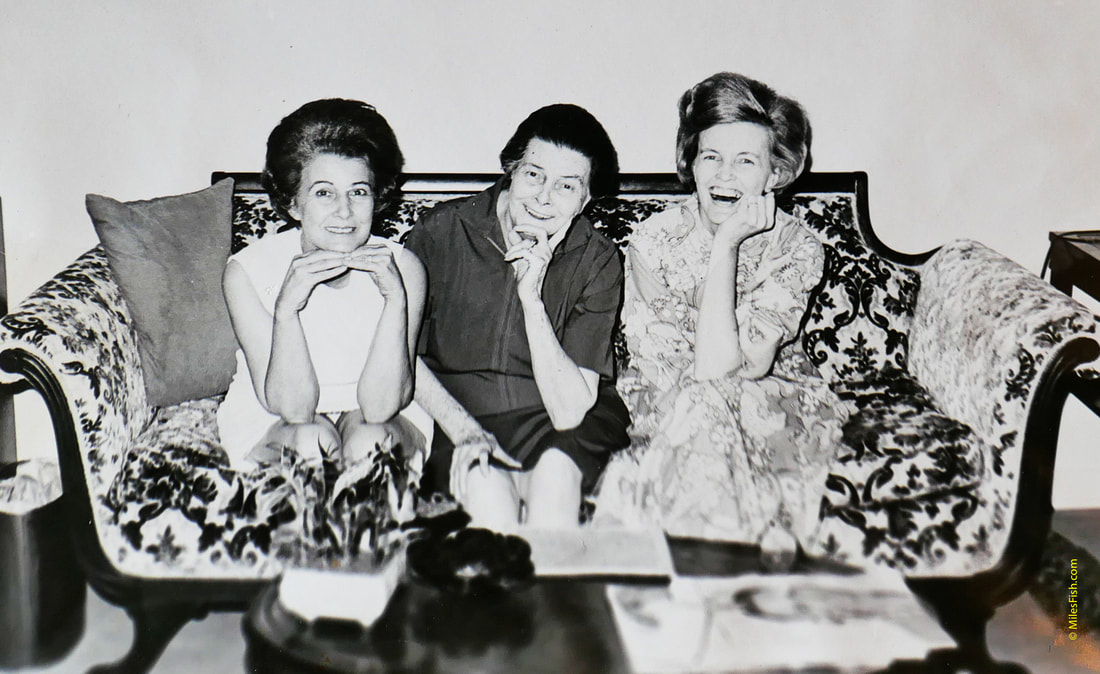
Auntie, BigMamma, Mother. (Evelyn Horne Holthoff, Evie Sparkman Horne, Anna Delle Horne Fish) I took this photo with my first SLR camera and developed the B&W print in BigMamma's bathtub. What a find: I'd forgotten all about it but the second I saw the photo I remembered shooting it like the day I took it was yesterday. I can still hear them laughing.
Eventually BigMamma sold her house and built a sort of apartment addition on to our house and moved in. The photo above is one of Auntie, BigMamma, and Mother (Evelyn Horne Holthoff, Evie Sparkman Horne, Anna Delle Horne Fish). It was taken in BigMamma's "apartment" when she moved in with us. I took it with my first SLR camera. I had just discovered the joys of developing my own photographs and this pic was developed in BigMamma's bathtub at the Star City house.
Fish Builders’ Supply and Lincoln Construction Co. were growing the whole time I was growing up especially after Daddy and Tom Lovett became partners and bought much of the existing large tracks of land inside the city limits and established several housing additions. (Tom and Daddy left the naming of the streets to Mother and Louis (Tom's wife, Steve Lovett's mother) so there are several family named avenues...as a matter of fact, there is a street named Miles and one named Fish and they happen to intersect so when you read the street sign at the corner, the street sign reads "Miles Fish".)
It was a busy time and Mother worked at the store most days so BigMamma and Sadie did the cooking. (Sadie Callaway was from Tarry, Arkansas a rural community smaller than Star City and located about 15 miles away between Star City and Pine Bluff. She lived in a nice house on a gravel road that paralleled the Pine Bluff highway. She road in from Tarry with a group of other black ladies who had similar jobs in Star City. She was there at mother and daddy’s when I was very young and she was still there when all of you were born. We loved her. She educated her children; one became a lawyer and one a doctor that I know of. She worked until she got sick, we’d moved by then, and when she died, her family ask mother to speak at her funeral. She had a wonderful dry sense of humor and she was a wonderful cook. That’s why I have such favorable memories and respect for southern cooking…I was raised on it from the two best cooks you could ever know.
They cooked a big from-scratch noon meal, always with a desert, and the leftovers from that big noon became a smaller evening meal (the meals were called: breakfast, dinner, and supper…”lunch” was something I did not have until I got to college). Sadie didn’t work on weekends and later when BigMamma was not in the best of health, Saturdays became a no-cook day. Everyone fixed what we call a “cold plate” fix-your-own. It was large dollops of tuna salad and fresh grated pimento cheese, with cold cuts on the side and either jello or a desert of pears smeared with Miracle Whip and sprinkled with fresh grated cheddar cheese (also know as rat-trap cheese…the kind you bought from the butcher by the pound). Sundays mother and BigMamma would prepare a roast with potatoes, carrots, and small onions slow cooked all morning in the oven in one pot and ready to serve just as we arrived home from church.
For a long time, we grew all our own beef on our land just outside Star City so those roasts were our roast; the land was about 450 acres and know as the Felley Place because the Felley family had originally owned it and had tried to grow cotton there many years ago. My dad called it The Rancho Grandy and we spent most weekends working the cattle there and my summer job was bush-hogging the pastures. When our freezer was getting bare, we’d take a cow to Pine Bluff, have it butchered and packaged into steaks, roast, and mostly hamburger meat. And we had three horses; “mine” was Star and I sometimes road Star in Lincoln County Fair parade. That land is the land where our first house was located; the one where y’all spent your early years. The land in front of the house was stilled lightly terraced from the old days the the Felleys grew cotton there.
When I was growing up we had our family household routine. Daddy had a meeting almost every night, it seems like or if he didn't have a meeting he worked late at the store. Deacons meeting, school board, Wed. night prayer meeting (which he never missed), Optimists Club, etc. When he got home we would "have our Cokes" with Cheezits and watch TV Paladin (Have Gun, Will Travel), Bonanza, Gunsmoke were his favorites but we also watch Hit Parade. After the Cokes, I would go back and watch TV with BigMamma.
She LOVED Johnny Carson and I would stay and watch Carson with her (we were the only ones in the house awake then). She referred to Johnny Carson like she would a friend. "Johnny" said this or "Johnny" said that last night. So every week night it was me and BigMamma and Johnny and sometimes on the weekends she would watch "Shock Theater" with me but she mostly dozed and I would wake her when the movie was over. When it was time for bed I would go to my room, I had a console record player and Daddy, who loved sleeping to music, would have a stack of records that would play for hours and you could hear the music in all the bedrooms. In the summers, with the windows open and the big attic fan humming and pulling air from all over the house, I would sleep with my head at the foot of the bed where my bedroom window was located and listen to the fan and Sinatra with Les Brown's orchestra followed by Peggy Lee (Latin ala Lee was his nightly choice). When I got a little older, I had a transistor radio about the size of a pack of cigarettes and on a clear night I would get under the covers and listen to the new music (rock n roll) on WLS Chicago.
Growing up, Reed Thornton (remember his Mom, Sue Reed Thornton had lived in the house with BigMamma's family) and I remained best friends. We spent almost every Friday night at Reed's house and on Saturday mornings we would have a breakfast of peanut butter on hot toast cut into four equal squares and a Coke over ice to drink. Then we played the encyclopedia game: we would each pick a volume of the Encyclopedia Britannica and find 10 or so interesting things. Then each of us would share our results. Then we would watch the Saturday morning TV shows like Sky King and My Friend Flicka. Best Saturdays of my youth.
 Anna Delle Horne Fish
Anna Delle Horne Fish
Mother finished high school a year early and went to Monticello A & M (now UA Monticello) and at age 16 she spent what would have been her high school senior year as a college freshman. She and Dorkas McGraw Tie Farley (B.F. McGraw’s sister) from Star City were roommates and remained lifelong friends. The next year she entered Hendrix as a sophomore. In those pre-war post-depression days most families were struggling while BigDaddy happened to be enjoying his hey-day. She said all of her friends had to work while at college and she thought she should do the same and so she worked every day on the cleaning detail at the Hendrix cafeteria.
Once, when she was at college, BigDaddy sent her a fur coat. (Both Auntie and Uncle Brother said she was his favorite…well she was the baby and had that Horne “elocution” gene in spades...they said that anytime THEY did something wrong they would try to talk mother into taking the blame because they knew BigDaddy would go easy on her if not dismiss the whole offense.) She said she just couldn’t wear the fur coat BigDaddy sent. Said it just didn't seem right because so many people were struggling during the war. So she left it hanging in the dorm closet.
 Charles Dayton Fish
Charles Dayton Fish
Her Junior year (I think) is WWII was going strong. Daddy had joined the Navy and signed up for flight school, was accepted, and went to Tulane University in New Orleans in order to become a Navy flight officer. He then went to flight school in Pensacola. When he received his wings he was transferred to DeLand, Florida.
When he arrived in DeLand, he telegraphed mother at Hendrix to pack her bags, take the train from Conway to DeLand and join him there and they would get married. So she telegraphed BigMamma and BigDaddy that she was leaving Hendrix to get married in Florida. (She said it was not an especially unusual story during those chaotic WWII times but it always seem like it was something out of movie to me.)
She packed her bags and left Hendrix College. She gave the fur coat to her roommate before leaving…after all she WAS going to Florida she would later laugh about giving away BigDaddy’s unworn fur coat but still, to me, it seems a nice, generous act (She could have these: innocent acts of generosity much like BigDaddy and Uncle Brother were remembered for.) Photo above, Hendrix yearbook photo, Right, daddy’s official Navy pic and below was taken after they were married in DeLand) (NOTE: Mother's obit stated that she and Daddy were married in Pensacola but I believe that is not correct because as kids we would to to see the church in DeLand where they were married...but then again...it's been a long time passing.)
When he arrived in DeLand, he telegraphed mother at Hendrix to pack her bags, take the train from Conway to DeLand and join him there and they would get married. So she telegraphed BigMamma and BigDaddy that she was leaving Hendrix to get married in Florida. (She said it was not an especially unusual story during those chaotic WWII times but it always seem like it was something out of movie to me.)
She packed her bags and left Hendrix College. She gave the fur coat to her roommate before leaving…after all she WAS going to Florida she would later laugh about giving away BigDaddy’s unworn fur coat but still, to me, it seems a nice, generous act (She could have these: innocent acts of generosity much like BigDaddy and Uncle Brother were remembered for.) Photo above, Hendrix yearbook photo, Right, daddy’s official Navy pic and below was taken after they were married in DeLand) (NOTE: Mother's obit stated that she and Daddy were married in Pensacola but I believe that is not correct because as kids we would to to see the church in DeLand where they were married...but then again...it's been a long time passing.)
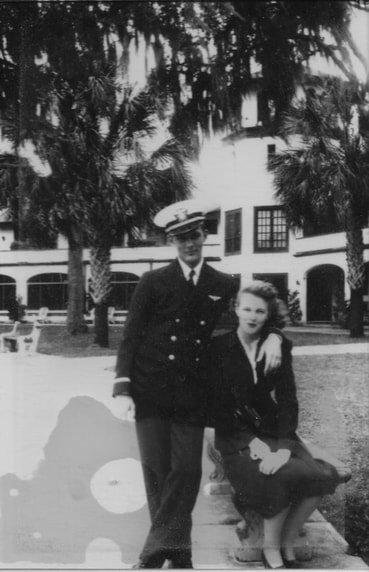 Dayton and Anna Delle Fish just married in DeLand, Florida
Dayton and Anna Delle Fish just married in DeLand, Florida
The whole time I was growing up, our family always took two weeks each summer and vacationed in Daytona Beach, Florida (Mother and Daddy were stationed in DeLand during flight training and they loved returning to the area. We usually went with Auntie and Claude (Holthoff) and their family. We sometimes played miniature golf and one summer I told Daddy I’d like to play real golf. So we did. He made reservations and rented us clubs. I was (and remained) pretty terrible at it but he was a natural right off the first Tee. We played almost every day that summer and clearly he could not get enough of it. And when we came back home to Arkansas? He bought his first set of golf clubs, joined Rosewood Country Club, sold all cattle of The Rancho Grandy, and spent the rest of his weekends on the golf course. It literally happened that fast. He was not an indecisive man. We kept going to Florida in the summers but now instead of Auntie’s family, it was with his golf foursome from Star City (and their families); they played 72 holes a day for two weeks. The Rancho Grandy became the Felly Place once again and Class Muckelroy who worked for daddy and helped look after the cattle, moved from the Rancho Grandy house that was built for him to town and the house became the rent house that the Carolyn Clary lived in when we were in Star City.
__________________________________
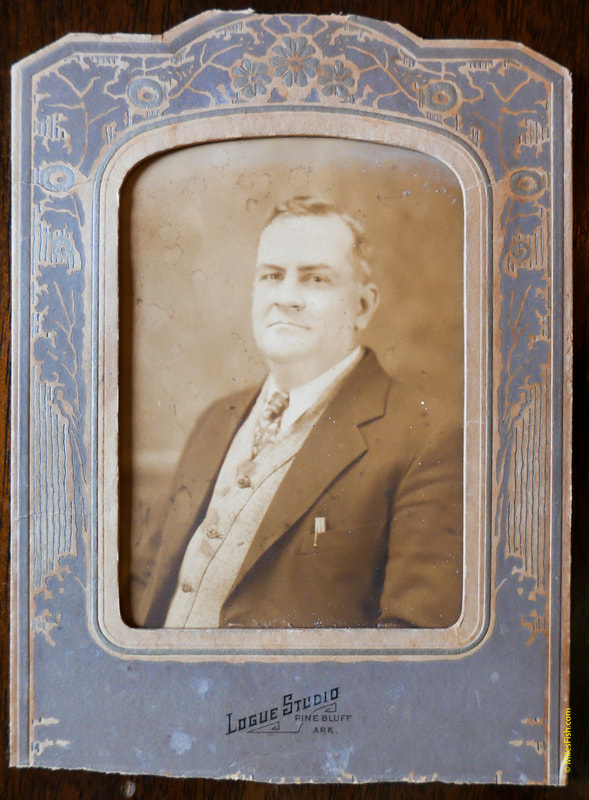 Garvin Fish, Dayton Fish's dad, my granddad.
Garvin Fish, Dayton Fish's dad, my granddad.
This is Garvin Fish, my Dad’s father, yall's great-grandfather. He was a merchant shop-owner with an accounting business on the side. We called him Granddaddy, his store in Gould, Arkansas was Fish Mercantile. It was a wonderful old general store/dry-goods/grocery and probably a stereotype of many small town general stores built in the 1930s and 40s. As I remember it, it was a long tall one-story building with large plate glass front windows for daylight. From the ends of plaid-looking cloth-covered branded wires there were exposed light bulbs hanging from the ceiling that must have been 20 feet from the floor or seem that high. There were small transom-like windows on the far upper sides for more daylight but out of reach for burglars I imagine. But day or night it always seemed dim inside. It was an all-wood unpainted plank interior floors and ceilings with brick walls, and there were ceiling fans—the really slow turning kind—and I remember the real breeze in the summer came from a big round silver fan on a tall silver pole near the back, the kind they had in all the churches during those times.
Granddaddy's store sold everything I suppose a rural Arkansas delta farming community might need but there were two things that I remember. In the center of the store there was a row of wooden kegs about three feet tall filled with seeds and beans. Pinto beans, Lima beans, corn, black eyed peas and you could push your hands and arms down deep a barrel of seeds and feel how cool and dry the seeds were and it felt like nothing else can feel (to this day, whenever we shell purple hull peas—and when we lived in Star City we shelled a LOT of them—I can run my hands through a dish full of peas and like a time machine, I am in Grandaddy’s store arm deep in a keg of cool dry seeds). The other thing I most remember was the big (maybe 2 feet across and 3 feet high) glass cylinder of Jackson's cookies that was on the long counter next to the monster size (by today's standard) cash register and we got a cookie after a visit. I always got lemon. My visual memory picture of Granddaddy's store, however flawed it might be due to the passage of time, is none the less clear to me and looks like a tintype old archive photo with images colored in tans and browns, off-whites, and no color to speak of with Granddaddy always standing at the big cash register. The store smelled of leather, seeds, and dust and lemon cookies...smells you don't get to smell any more and smells you don't forget.
Granddaddy was also an accountant who kept books for some farmers in the area including Claude Holthoff, Sr (my uncle Claude’s father) who was one of Arkansas's largest land owners. The Fishes and the Holthoffs lived across the street from each other so it was a convent business arrangement location wise. Also, across from Granddaddy's house beside the Holthoff house was the Spurlock house where Helen Cogbill Spurlock grew up. She and daddy were good friends and each of their bedrooms faced the street. They used to tell stories about sleeping next to the screened windows in the summer and talking back and forth across the street during the nights.
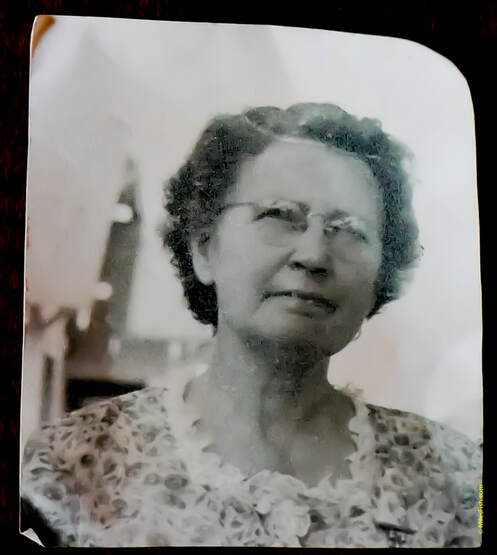 Myrtle Fish, Dayton Fish's mother, my grandmother.
Myrtle Fish, Dayton Fish's mother, my grandmother.
And this is Grandmother Myrtle Fish (below). She died when I was very young. When I was growing up, Mother said that the only time she ever saw Daddy cry was when they told him that his Mother had died. And he went to the bedroom and closed the door and cried all afternoon. I don’t remember much about her except she was small and thin, wore grannie glasses, and it seems that she always wore soft silky dresses printed with little flowers like the one in the photo. As a matter of fact, when I found this old photo, I didn’t at first recognize the face in the picture but it was that dress that kept reminding me of who she was.
She cooked muffins for me when I came to visit and on rare occasions I would spend the night. The one other image was of her always at her sewing machine. The sewing machine was placed in the front unused bedroom. It was manual; it was a wooden console with little drawers on the sides and a mostly shinny iron black sowing machine on top and it had a grill-work platform attachment, maybe 2' X 3') that hung down near the floor and she would move the grillwork back and forth front to back with both feet to make the machine needle move up and down. Once you hear that precise mechanism click-click-click-click sound speeding up and slowing down and stop and speeding up and slowing down and stop you never forget it. When she and Granddaddy were first married they left Gould; she didn’t like the mosquitoes and heat in the summer so they bought land—an orchard—in Phoenix, Arizona and moved there. But they missed family and fiends and became more and more unhappy there. So they sold the orchard and moved back to Gould. I was told that the orchard they bought and sold is now part of downtown Phoenix.
After she died, Granddaddy, due to ill health, eventually moved in with Thurston and that's where we would visit him.
We drove to Gould a lot when I was growing up with two sets of relatives there and all. (Auntie’s family—Claud Hotthoff, jr, and Johnny, Katie, Suzanne) and Daddy’s family (Grandmother and Granddaddy—with Thurston and Jennet with Mike and Melanie also in Gould and Carrol and Gladys and Carrol Ann in nearby Pickens.) The road from Star City to Crigler (about 1/2 way to Gould) was paved but the road from Crigler to Gould was still gravel. I remember onetime we were coming back from Gould and a dense fog set in and we had to slow down to a crawl to see the road and when we got to Crigler finally we could safely go faster because of the little white lines in the center of the blacktop.
She cooked muffins for me when I came to visit and on rare occasions I would spend the night. The one other image was of her always at her sewing machine. The sewing machine was placed in the front unused bedroom. It was manual; it was a wooden console with little drawers on the sides and a mostly shinny iron black sowing machine on top and it had a grill-work platform attachment, maybe 2' X 3') that hung down near the floor and she would move the grillwork back and forth front to back with both feet to make the machine needle move up and down. Once you hear that precise mechanism click-click-click-click sound speeding up and slowing down and stop and speeding up and slowing down and stop you never forget it. When she and Granddaddy were first married they left Gould; she didn’t like the mosquitoes and heat in the summer so they bought land—an orchard—in Phoenix, Arizona and moved there. But they missed family and fiends and became more and more unhappy there. So they sold the orchard and moved back to Gould. I was told that the orchard they bought and sold is now part of downtown Phoenix.
After she died, Granddaddy, due to ill health, eventually moved in with Thurston and that's where we would visit him.
We drove to Gould a lot when I was growing up with two sets of relatives there and all. (Auntie’s family—Claud Hotthoff, jr, and Johnny, Katie, Suzanne) and Daddy’s family (Grandmother and Granddaddy—with Thurston and Jennet with Mike and Melanie also in Gould and Carrol and Gladys and Carrol Ann in nearby Pickens.) The road from Star City to Crigler (about 1/2 way to Gould) was paved but the road from Crigler to Gould was still gravel. I remember onetime we were coming back from Gould and a dense fog set in and we had to slow down to a crawl to see the road and when we got to Crigler finally we could safely go faster because of the little white lines in the center of the blacktop.
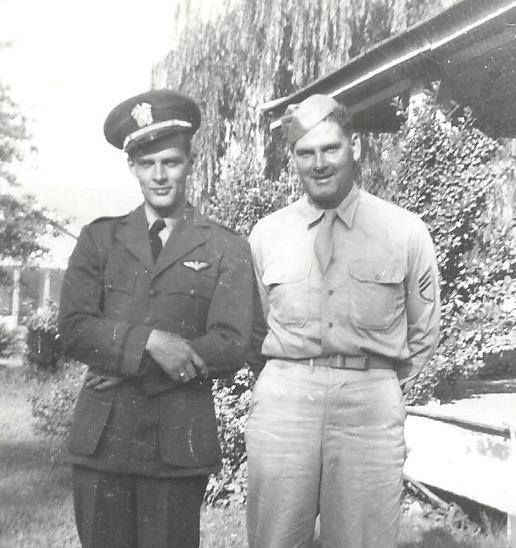 Daddy with Uncle Thurston (Gould) during the war
Daddy with Uncle Thurston (Gould) during the war
Daddy had three brothers and I knew them and their family well when I was growing up. There was Thurston, Carrol, Douglas, and Daddy. And there was a sister but she died of pneumonia when she was a young girl. When Granddaddy went to live with Uncle Thurston and Aunt Janette (and my cousins Mike and Melanie) Thurston took over the store at the new location—the location where it was the whole time we were in Dumas. T.M.Fish Mercantile evolved from a dry goods store into a mostly grocery store but he still carried things like work boots and stuff.
Carrol was the accountant for R.A Pickens Plantation and lived in a wonderful two-story house next to the Pickens family. His only daughter, Carrol Ann, and I were close growing up and I usually spent a least a week with them in the summers. It was the only two story house I had ever stayed in. I remember she had her own horse and staying there was a treat because the Pickens community had a great swimming pool and we could walk there every day and swim and they had an event, I remember, called “Dip-Dine-Dance” and I thought that was cool. This was such a treat because there was no swimming pool in Star City when I was growing up. (However, and in true southern fashion, we dammed up Cane Creek near Reed's house with burlap bags of sand and created our own swimming hole that was actually pretty impressive and we would sometimes camp out there in our pup-tents.)
And they had a 9 hole golf course and Aunt Gladys, Carrol’s wife played golf every day while we swam. Later all of you guys (Milo, Jason, Spencer, Nicholas, Emily) would go to that same pool and golf course. Later on, Byretta and I would go to dinner at the Pickens club restaurant and R.A. and his second wife Carol would sometimes join our table. R.A. loved to drink and after a few he would delight in telling us “Every investment million dollars I made, I made because of Carrol Fish.” Which begs the question why didn’t Carrol make his own million and the answer is well known: he did. Uncle Douglas and his wife Jackie and their three girls, lived in Little Rock when I was very young. We would visit them occasionally and I remember Jackie and the girls were Catholic so the girls got to eat fish every Friday at their school and I thought that was neat…and weird…couldn’t quite figure that one out at the time. They soon moved to Bakersfield, California and they went to Disneyland all the time or so it seemed. Disneyland was brand new and seemed like an unachievable dream like Hollywood or New York City. And there was the Mickey Mouse Club on TV and I watched it after School. Once the girls came from Bakersfield to visit us in Star City and brought me Mouseketeer Ears and you’d have thought they'd brought me the Holy Grail (well, for me, they kind of had). I imagined that I had the only Mouseketeer ears in all of Star City that came directly from Disneyland and I was probably right. I just couldn’t imagine how such a wonderful thing could happen to me.
The End for Now
Carrol was the accountant for R.A Pickens Plantation and lived in a wonderful two-story house next to the Pickens family. His only daughter, Carrol Ann, and I were close growing up and I usually spent a least a week with them in the summers. It was the only two story house I had ever stayed in. I remember she had her own horse and staying there was a treat because the Pickens community had a great swimming pool and we could walk there every day and swim and they had an event, I remember, called “Dip-Dine-Dance” and I thought that was cool. This was such a treat because there was no swimming pool in Star City when I was growing up. (However, and in true southern fashion, we dammed up Cane Creek near Reed's house with burlap bags of sand and created our own swimming hole that was actually pretty impressive and we would sometimes camp out there in our pup-tents.)
And they had a 9 hole golf course and Aunt Gladys, Carrol’s wife played golf every day while we swam. Later all of you guys (Milo, Jason, Spencer, Nicholas, Emily) would go to that same pool and golf course. Later on, Byretta and I would go to dinner at the Pickens club restaurant and R.A. and his second wife Carol would sometimes join our table. R.A. loved to drink and after a few he would delight in telling us “Every investment million dollars I made, I made because of Carrol Fish.” Which begs the question why didn’t Carrol make his own million and the answer is well known: he did. Uncle Douglas and his wife Jackie and their three girls, lived in Little Rock when I was very young. We would visit them occasionally and I remember Jackie and the girls were Catholic so the girls got to eat fish every Friday at their school and I thought that was neat…and weird…couldn’t quite figure that one out at the time. They soon moved to Bakersfield, California and they went to Disneyland all the time or so it seemed. Disneyland was brand new and seemed like an unachievable dream like Hollywood or New York City. And there was the Mickey Mouse Club on TV and I watched it after School. Once the girls came from Bakersfield to visit us in Star City and brought me Mouseketeer Ears and you’d have thought they'd brought me the Holy Grail (well, for me, they kind of had). I imagined that I had the only Mouseketeer ears in all of Star City that came directly from Disneyland and I was probably right. I just couldn’t imagine how such a wonderful thing could happen to me.
The End for Now
